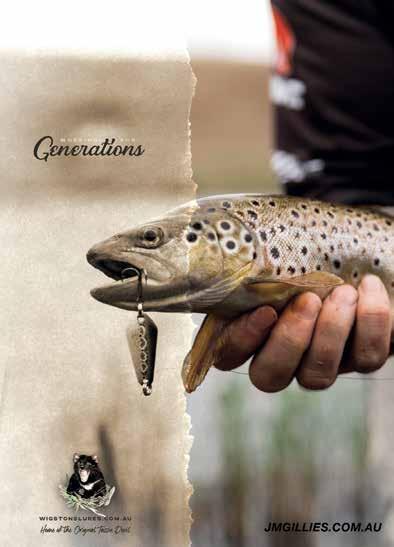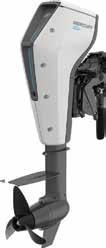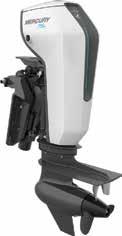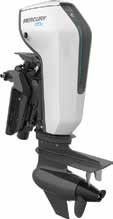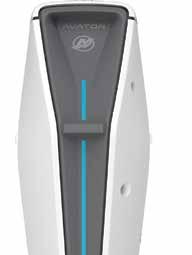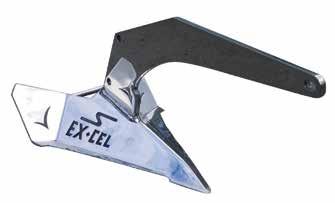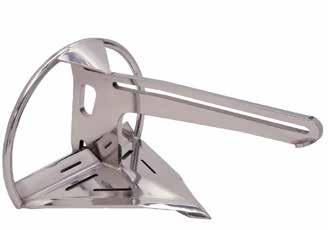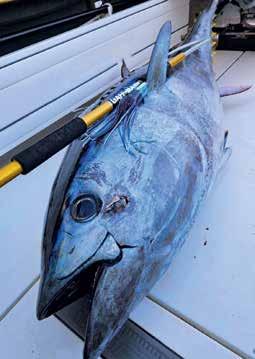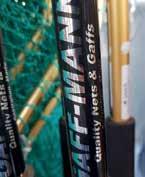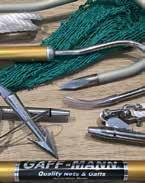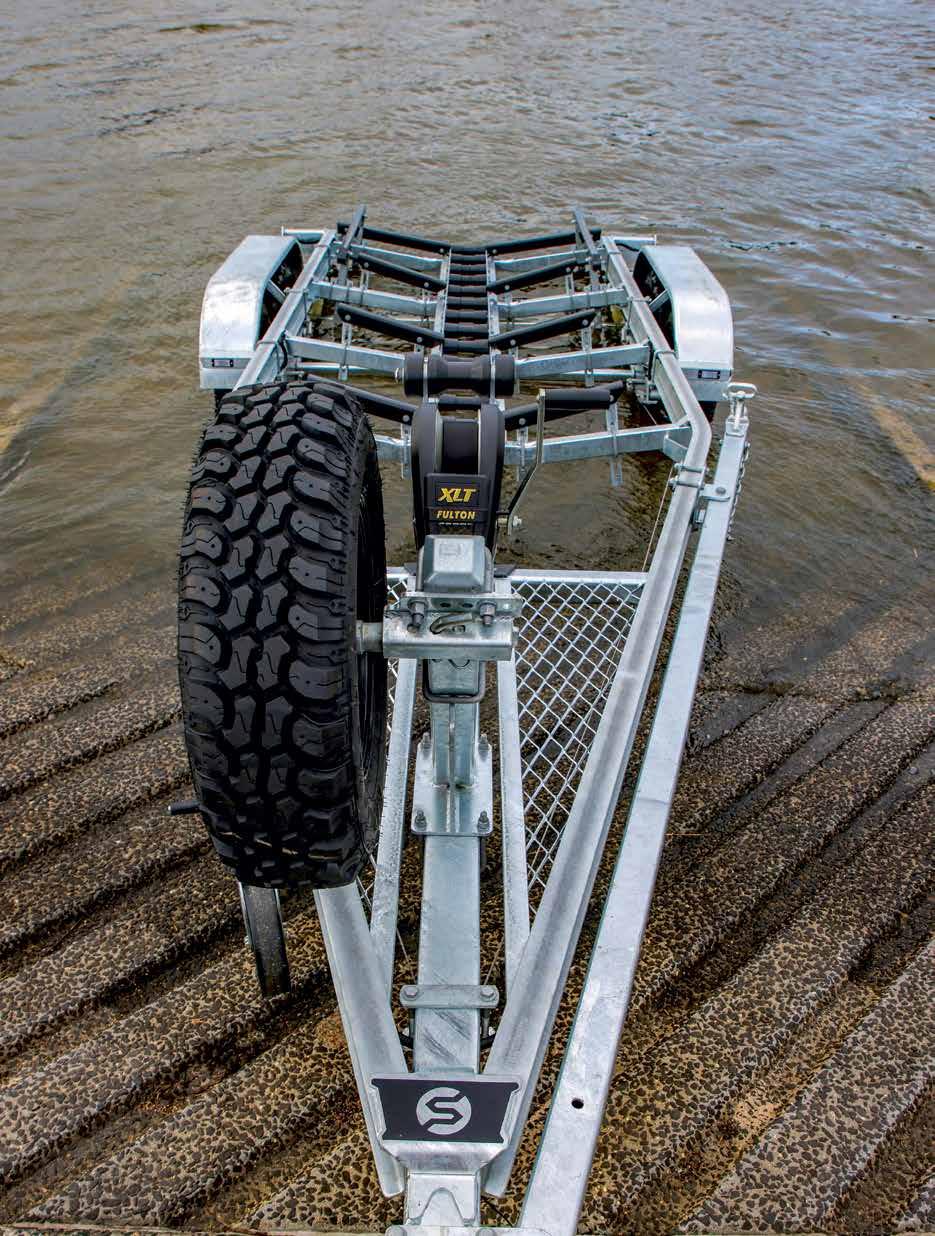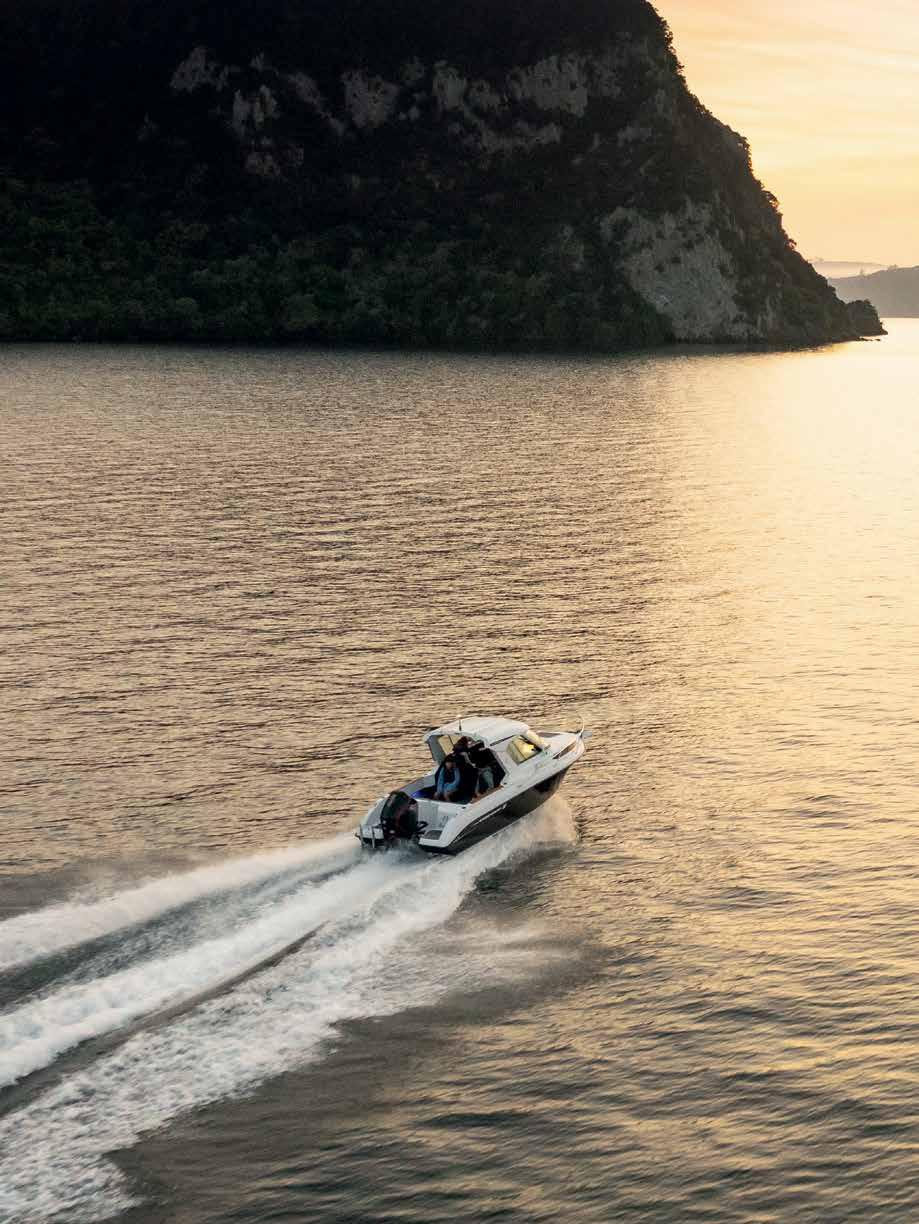










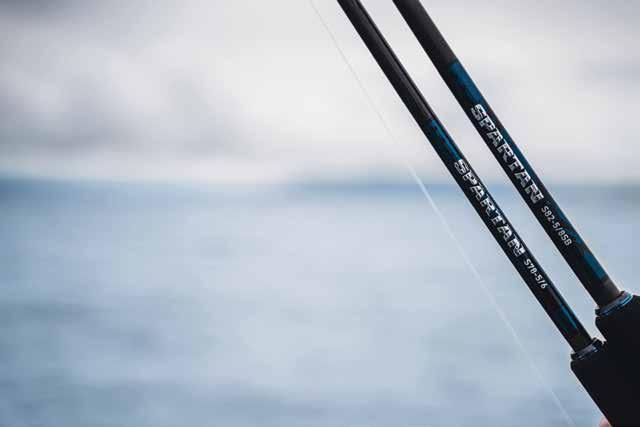
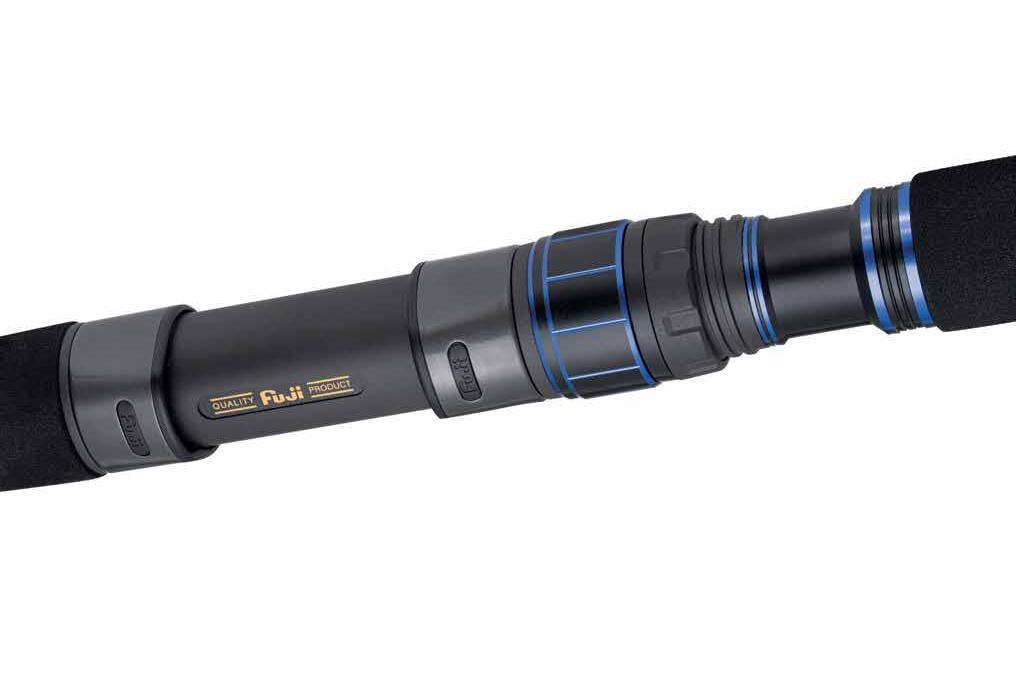
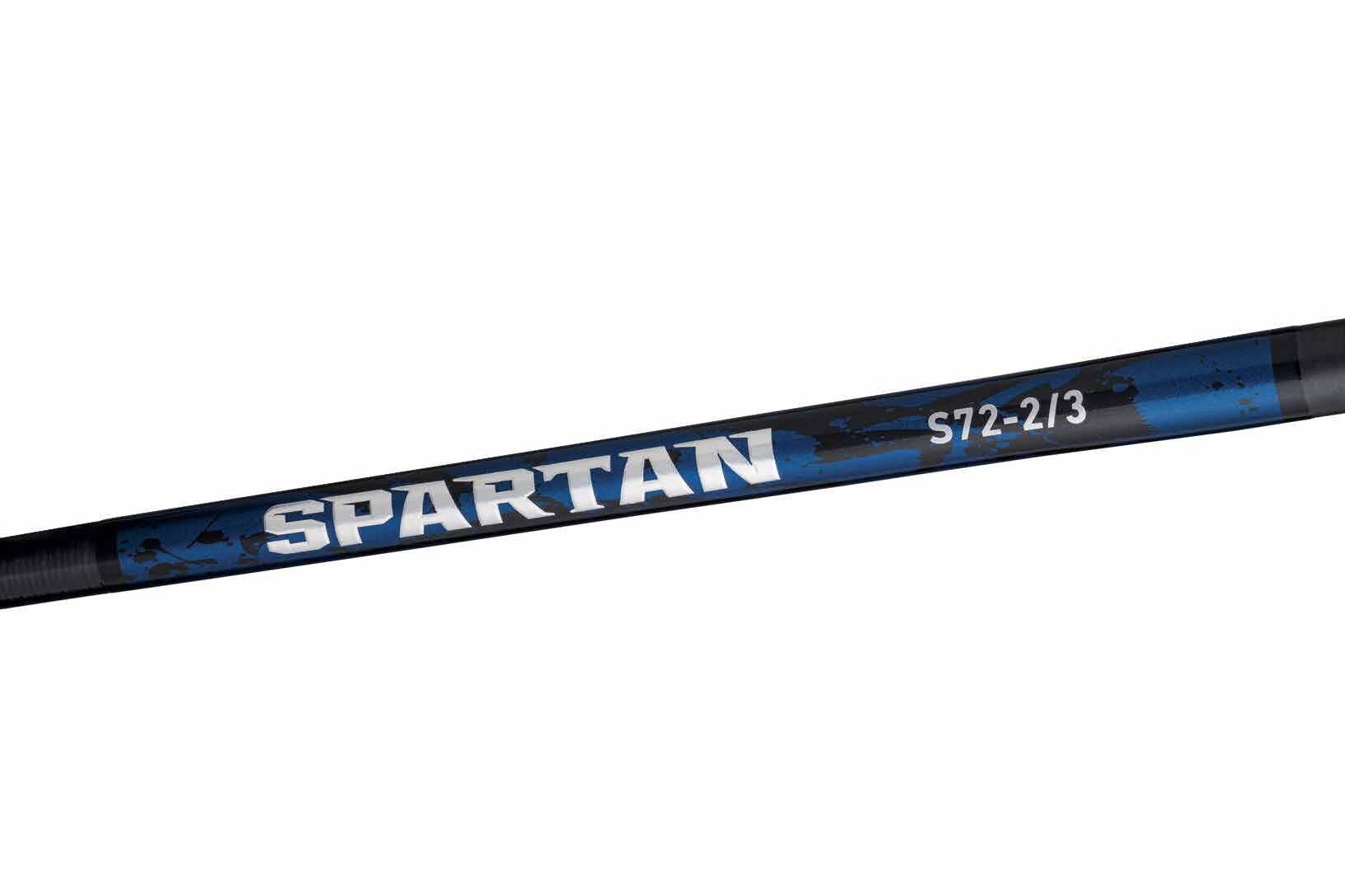


Flick through this issue of Hooked Up and you might spot the odd ad or a news release for a hook specifically aimed at bait anglers – but beyond that? Not much when it comes to bait anglers. Where are the rods purpose-built for bait fishing? Where’s the terminal tackle that gets the same thought, detail and pride poured into it as lure gear?
It’s a gaping hole in the market, and it’s about time we started talking about it. Don’t get me wrong, there are some companies leading the charge such as the team at Vexed. They have made some outstanding new products that mix bait and lures, are fun to use and effective, but 95% of the gear on the market is aimed at lures, and of that much of it is quite generic.
I raise this in our review of the new Lox QX10 King George Whiting rod elsewhere in this edition – a rare example of a company that has designed a high-quality bait rod for a specific species and technique. It got me thinking: why aren’t we seeing more of this?
Look to Europe and bait anglers are spoiled for choice. Beautifully made floats. Speciesspecific hooks. Beads that don’t shatter. Sinkers that won’t have the swivel break or pop out after limited use. Rods that aren’t just cheap bargain bin specials, but sensitive, strong and tuned to the job. That kind of design is standard over there.
Meanwhile, here in one of the most fishrich countries on the planet, bait anglers are treated like the ugly sister of sportfishing –and that’s despite the fact they outnumber lure anglers by a mile. Head into a tackle shop looking for a serious bait rod for whiting, bream, garfish, snapper or gummies and what are you offered? Ugly Stik, Southern Snapper, maybe something from Atomic – credit where it’s due, at least they’re trying – but it’s still not great. Then there’s all the rebadged, Chinesedesigned rods from the Pure Fishing and Rapala stables. No thanks. It’s just not good enough. I can get any rod I want, and I have quality gear, yet not one of the bait rods I use for gummy sharks, snapper, whiting or garfish was designed for that purpose, I just found other rods that almost fit the bill.
I’ve heard the excuses: “Bait anglers don’t want to spend the money… they don’t need refined gear.” Maybe there’s a sliver of truth in that. But it’s also a cop-out. The manufacturers need to lead and those that are, are seeing results. Show anglers what’s possible, design purpose-built gear that’s genuinely worth buying and they’ll get on board.
And this goes beyond just bait tackle – it’s about purpose-built design. How many press releases do you read where a lure or rod is pitched as “perfect for barra, cod, mulloway, flathead and more”? Anglers want gear designed for a specific species and technique. Sure, there’ll always be crossover, but colour, size and action all matter. For too long, Australians have been spending a hundred bucks on lures made for fish halfway around the world, then modding them with upgraded split rings, trebles, sticky weights and a prayer. That’s not good enough.
Rods are often the same with lure techniques; go out and try and find a rod suited to casting big baits for flathead in spin or overhead (a hugely popular technique now) and the range is extremely limited.
It doesn’t have to be this way. Miller Rods has shown what’s possible – building an entire business on species and technique-specific rods. It works because as it’s done with intent, and it’s done well. If a small operator can do that in Australia, then so can the big guys.
What we need now is a shift in mindset. We need rods built for real bait fishing – longer butts, full EVA, true actions, bite sensitivity and enough backbone to swing a sinker and a fish over the side. We need terminal tackle that’s smart, strong and well-made – not an afterthought in a catalogue. And we need more rods that are designed for a specific fish and technique.
I guarantee you this, the first company that purpose-designs (with actual thought, design and proper R&D) and markets a series of baitspecific rods will absolutely kill it. Right now, we’re on a steady slide into mediocrity. And for a country this obsessed with fishing, that’s just not good enough.
Kosta Linardos. Editor-in-Chief

CONTRIBUTORS
Joel Ryan, Sam Gilchrist, Jamie Crawford, Adam Hewson, Dean Linardos, Ethan Linardos

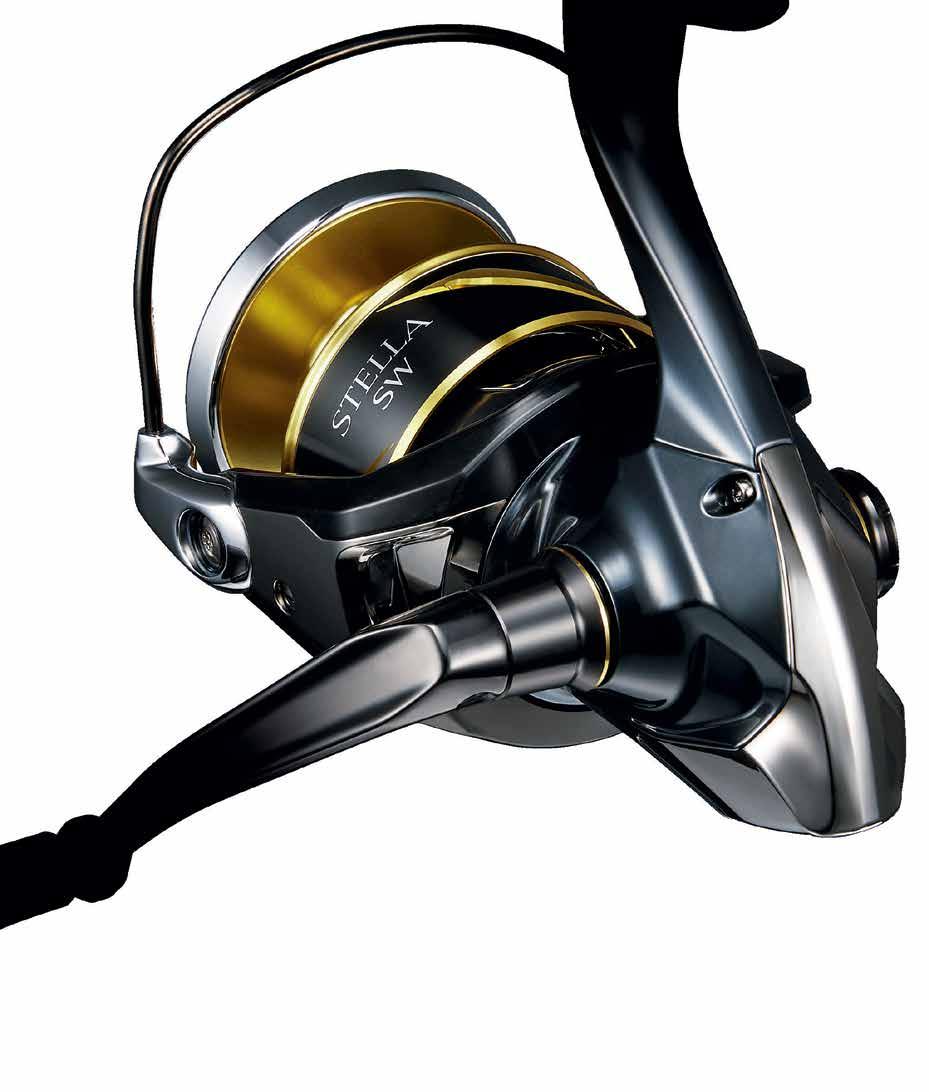




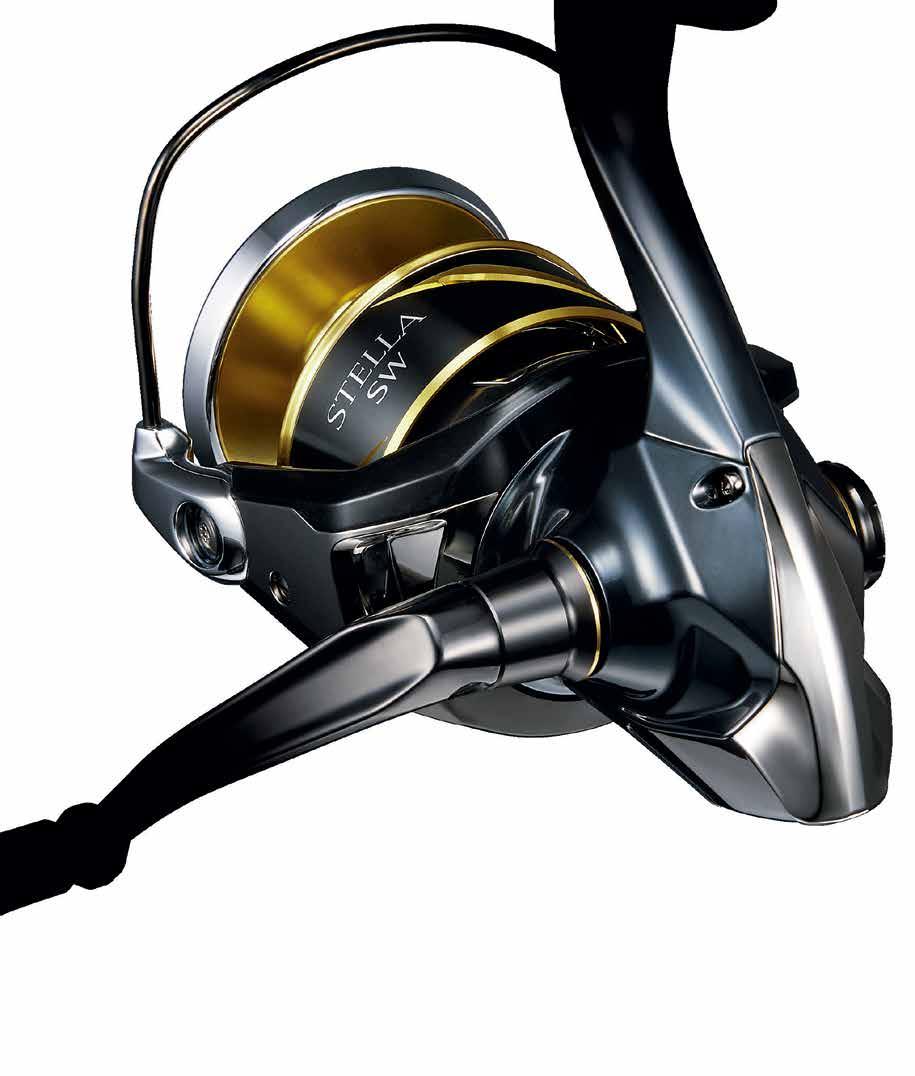
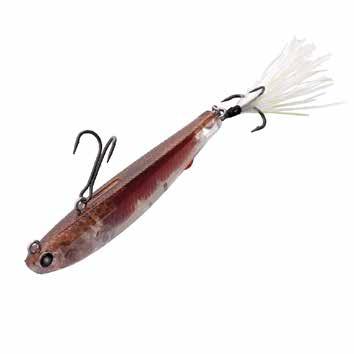
Tiemco’s Glimmer series sets a new standard for strolling techniques with a design tailored to finesse anglers. Developed in Japan, it mimics a wandering minnow to entice bites from even the most pressured fish, excelling in hover, mid, and bottom strolling—techniques proven in major tournaments. Perfect for Australian species like bass, estuary perch, bream, jacks, golden perch, trout, and flathead, the Glimmer series offers unmatched versatility. Equipped with a rear treble and a magnet-secured top double hook, Glimmer ensures exceptional hookup rates while maintaining a precise and natural presentation. Its detailed colourways match local forage, while the internally weighted Glimmer 7 delivers excellent casting and works effectively at depths of 3-10ft. For best results, cast beyond your target, let the lure sink, and retrieve slowly. A gentle rod shake creates a side-to-side roll, adding flash that draws in even passive fish. Ideal for tough conditions, the Tiemco Glimmer is a must-have for anglers targeting Australia’s diverse species with finesse techniques.
ejtodd.com.au
The Evergreen Metal Master is a bite-triggering jigging spoon that combines a long flight time with a horizontal fall, irregular rolls, and fluttering action. Effective for both vertical and casting applications, it delivers an irresistible flutter on the drop rather than sinking straight down. Fitted with the innovative “Hell Hook System” — two silkycoated Decoy Big Bite Finesse hooks set internally — the Metal Master resists snagging and improves hook-up rates. A custom-made half-split ring enhances hook freedom and reduces the chance of tangles, ensuring a more reliable presentation every cast. gladiatortackle.com.au
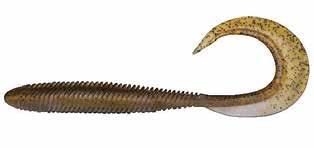
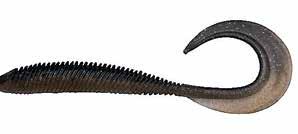
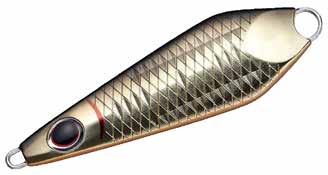
The Megabass Kemuri Curly is a standout grub designed by expert lure creators at Megabass. Its ribbed body and wide, thick tail provide excellent balance, making it irresistible to both freshwater and saltwater species. With a low centre of gravity, it delivers a stable swimming action in any tide. The finely carved ribs produce subtle waves that enhance its allure, ensuring it catches the attention of fish in a variety of environments. The Kemuri Curly is available in three sizes of 2.5in, 3.5in and 4.5in and comes in a huge variety of colours. vivafishing.com.au
McLures has released some new models for 2025 just in time for the Southern Bluefin Barrel run and Marlin season. The Baja Jet is a unique lure that offers a bullet shaped head but also offers 4 jet holes for an increased bubble trail. These lures are best used at higher speeds and run a bit further back than traditional skirts.This lure is ideal for Barrel Tuna, Marlin and other high speed pelagics. They come with many different head colours matching the skirts with some glow heads, some tinted and some offering Kauri Shell. These lures come with most of the range offering a UV over skirt whilst the underskirt offers McLures exclusive “Luminite” (which glows in the dark on all colours). They also come with Red Crystal 3D Eyes and are ‘Keel Weighted’ for perfect swimming action. The Baja Jets are 9.5” long overall with a skirt length of 8” and weigh 100grams. They are available in 12 brilliant colours. These lures are deadly on Yellowfin Tuna, Southern Bluefin Tuna and all Marlin species jurofishing.com.au
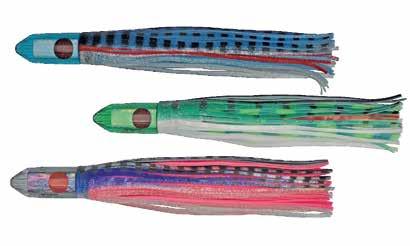
The Infeet Reflex 38 is a collaboration between Daiwa Australia and Kazuya Niwatoko of Trinity Baits in Japan. Originally developed in a larger size for largemouth bass, the Reflex has been refined into a 38mm vibration bait to target estuarine species such as bream, perch and bass. Its ability to shimmy as it falls is unique for a vibration bait, perfectly imitating forage like mussels, crabs and baitfish. Ideal for fishing close to vertical structure like bridge pylons or targeting fish suspended under boats and pontoons, the Reflex 38 offers incredible versatility. Fitted with BKK Spear 21SS trebles and quality split rings, it is ready to fish straight from the pack. A wide range of colours is available to match any local bait and water condition, making the Infeet Reflex 38 a deadly addition to any light-tackle arsenal. daiwafishing.com.au

Don’t let the name fool you – Super Jigman is an all-round coastal braid, perfect not only for jigging but also for casting, trolling, or bottom bashing. This 8-strand braid is built using X-Braid’s proprietary WX construction, which prevents fibre twist during braiding – delivering a smooth, balanced line with high abrasion resistance and excellent water-shedding performance. It’s colour-coded for easy line tracking, with 10m intervals in blue, pink, red, green, and white. Super Jigman stands out in its class, delivering the kind of reliability and performance coastal anglers usually expect from much pricier braids. Available in 200m and 300m spools. xbraid.com.au
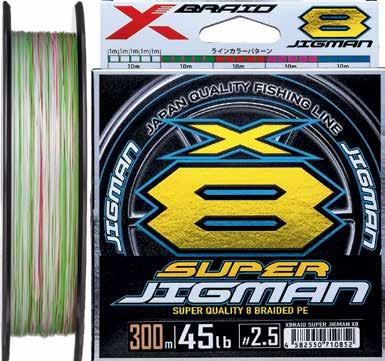
The Salty Crew Sailfish Snap Jacket is built for tough conditions with heavyweight nylon fabric and a water-resistant coating. Featuring a three-piece hood, Salty Crew branded snaps, drawcord hem, underarm ventilation eyelets, elastic cuffs and bold front and back screen prints, it’s made for anglers who need durability and comfort. Crafted from 100% Nylon Taslon, it offers a relaxed fit perfect for layering. Available in sizes S to XXXL for A$129.99.
salty-crew.com.au
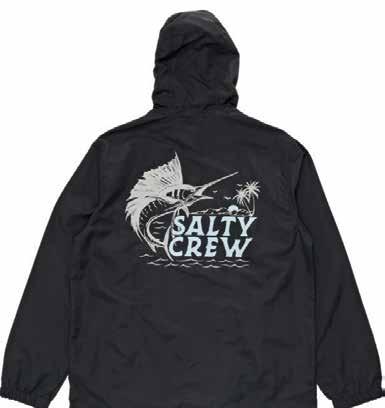

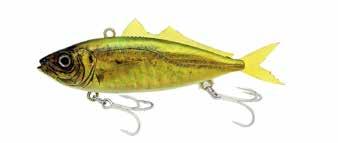
The Little Jack Zeigos is engineered with a precision-crafted, hyper-realistic silhouette and delivers a sharp, tight-action response that reliably triggers predatory instincts. Independently moulded pectoral, dorsal and caudal fins made from a soft elastomer material enhance micro-movement and generate highly natural hydrodynamic behaviour. Designed for lifelike performance in the water, the Zeigos offers incredible realism that fools even wary fish. Available in 55mm/9g, 65mm/14g and 75mm/22g sizes, it covers a wide range of species and fishing conditions. A deadly addition for anglers chasing fish that demand the most natural presentation possible. gladiatortackle.com.au
The 3D Magnum & 3D Diver feature a tough ABS Resin body, 3X strong treble hooks with a through wire construction in the 180mm making it the most durable trolling lure of its type on the market. Yo-Zuri’s proprietary and patented Internal 3D Prism finishes are extremely durable and put off light in all directions, makes these baits stand out in any fishing condition!!! They are designed to be fished with a crimp, loop knot, cable or single strand wire, to give the bait the freedom to swim correctly. 3D Divers are deadly on a number of offshore species including Tuna, Wahoo, Dolphin and Mackerel, just to name a few. This versatile trolling lure can be pulled from 4-9 knots with a wide swimming action and runs true out the box, no tuning
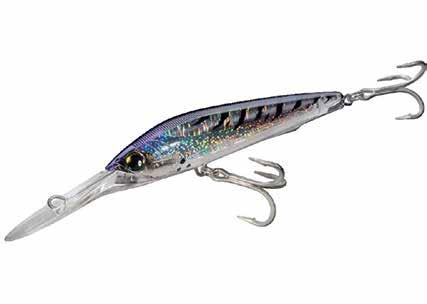
The Fathom Check Shacket in Brown from Salty Crew is made from mid-weight brushed polyester with a warm polar fleece lining. It features in-seam pockets, a two-piece collar and Salty Crew branded snaps at the centre front. Built for comfort and versatility, it’s ideal for
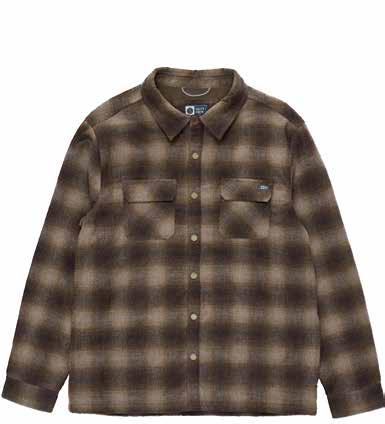
The most anticipated saltwater spinning reel is coming soon to Australian shores. Built to handle the largest and most powerful ocean species under the harshest marine conditions, the new Shimano Stella SW is designed to “Conquer the Impossible.” Stella SW has been a trusted icon for over 30 years, and this latest version takes saltwater reel engineering to the next level. It features the superbly efficient XX-TOUGH drag system, INFINITYXROSS gearing, INFINITYLOOP line laying, and an ANTI-TWIST FIN for smoother casting and cranking under heavy load. An up-sized drag knob allows for precise adjustments during battle, while improved X-PROTECT and X-SHIELD systems offer next-level durability. Available soon in three models — the powerful 10000PG, the versatile 10000HG, and the high-speed 14000XG — the new Stella SW promises to be the ultimate companion for serious saltwater anglers.
shimanofish.com.au

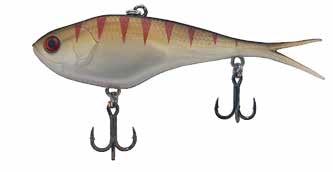

The new Killalure Tropic Lolly is built to withstand tough fishing conditions while delivering lifelike movement. Crafted from TPE (Thermoplastic Elastomer), it offers exceptional flexibility and durability, allowing it to bend, stretch and move naturally in the water while standing up to aggressive strikes. Featuring advanced hooks and hardware, this lure boasts a strong vibrating action that fish find irresistible, whether you’re working it for mulloway or barra in rivers or fishing offshore reefs for demersals. Available in eight colours, measuring 130mm and weighing 60g. jmgillies.com.au

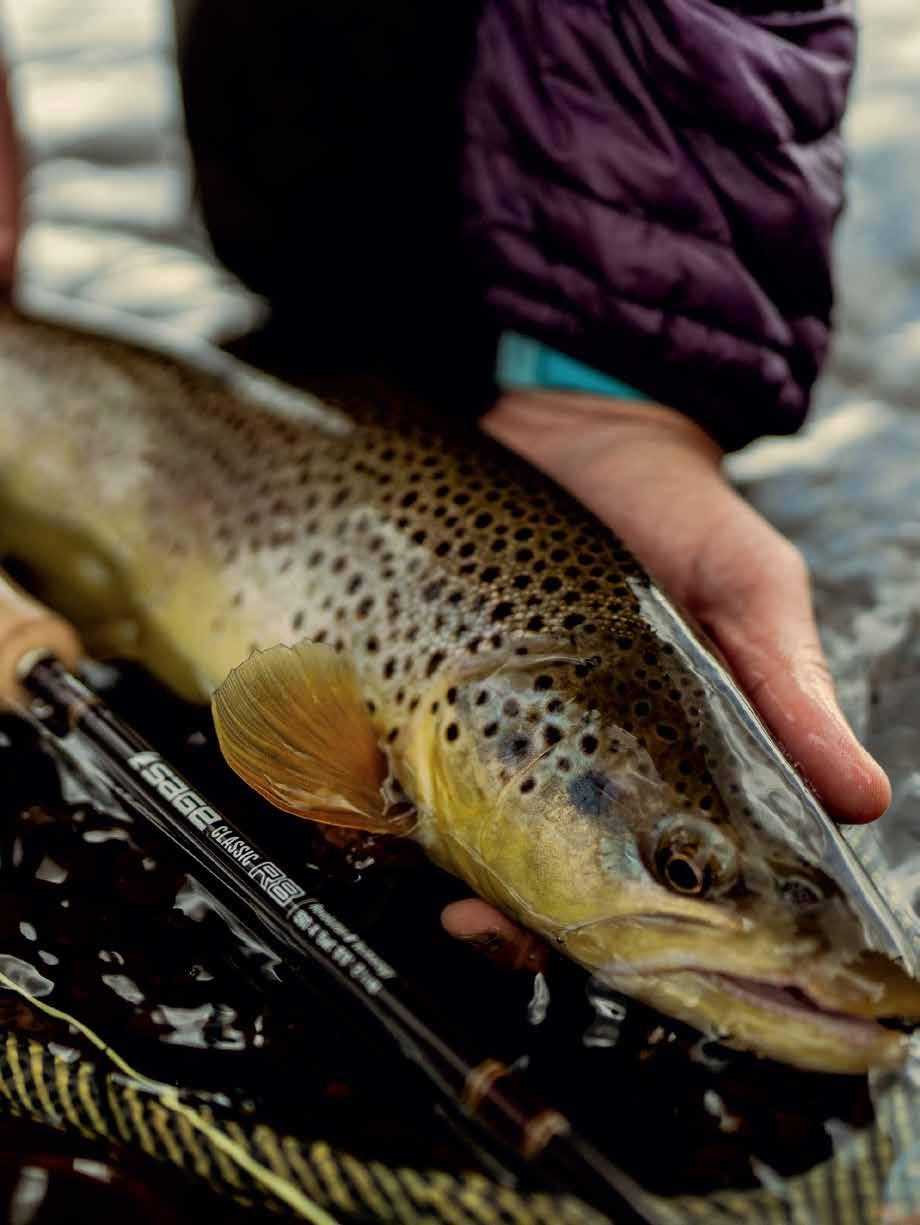

The next evolution of the Spartan rod series has arrived, the 25 Spartan. Retaining the elements that made the original a standout, the new series goes to another level in design, comfort and performance. X45X Full Shield technology returns, delivering unmatched strength while reducing blank twist to optimise casting performance and efficiency. Lighter and crisper in the hand while keeping the proven actions and tapers the range is known for, the 25 Spartan offers increased sensitivity without compromising durability. Crafted with Fuji stainless steel SiC guides and featuring newly contoured grips for better comfort and control, these rods are built for casting, jigging and fighting tough offshore species. Designed to outcast, outperform and outclass both its predecessor and the competition, the 25 Spartan sets a new standard in offshore precision, power and comfort.
daiwafishing.com.au

Molix has introduced three exciting new colours to their highly popular Shad 140 range, expanding the options for anglers targeting iconic Australian species like barramundi and Murray cod. The new colours— Aussie Dark Flash, Aussie Clear Flash, and Blue Black Herring—have been carefully designed to suit a variety of fishing conditions and environments, ensuring maximum versatility and appeal. Each colour option offers unique benefits, with the Aussie Dark Flash providing a striking, bold profile perfect for murky waters, while the Aussie Clear Flash delivers a subtle, natural look ideal for clear water conditions. Meanwhile, the Blue Black Herring mimics the appearance of baitfish commonly found in Australian waters, making it an irresistible choice for predatory fish. With their lifelike action, durability, and now an expanded colour range, the Shad 140 lures continue to be a favourite among Aussie anglers looking to improve their chances of landing trophy-sized fish.
ejtodd.com.au
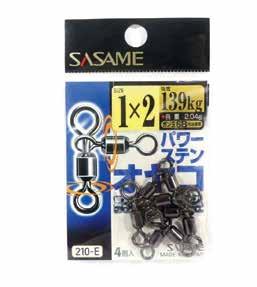
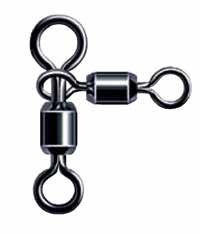
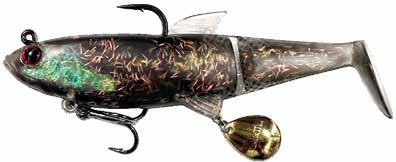
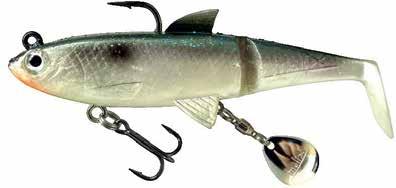
The Sasame 210E Rolling 3-Way Swivel is a versatile and reliable piece of tackle designed to simplify your fishing setup. With its innovative 3-way design, this swivel allows you to easily connect multiple lines or components, making it perfect for a wide range of fishing rigs and applications. The Sasame 210E offers the flexibility you need to keep your setup running smoothly when bottom fishing. Crafted from highquality materials, the Sasame 210E is built to last, providing exceptional durability and performance. It is resistant to corrosion, making it equally suited to both freshwater and saltwater environments. The swivel’s smooth rotation ensures tangle-free operation, effectively preventing line twists and knots that can cause frustration during your fishing sessions. vivafishing.com.au
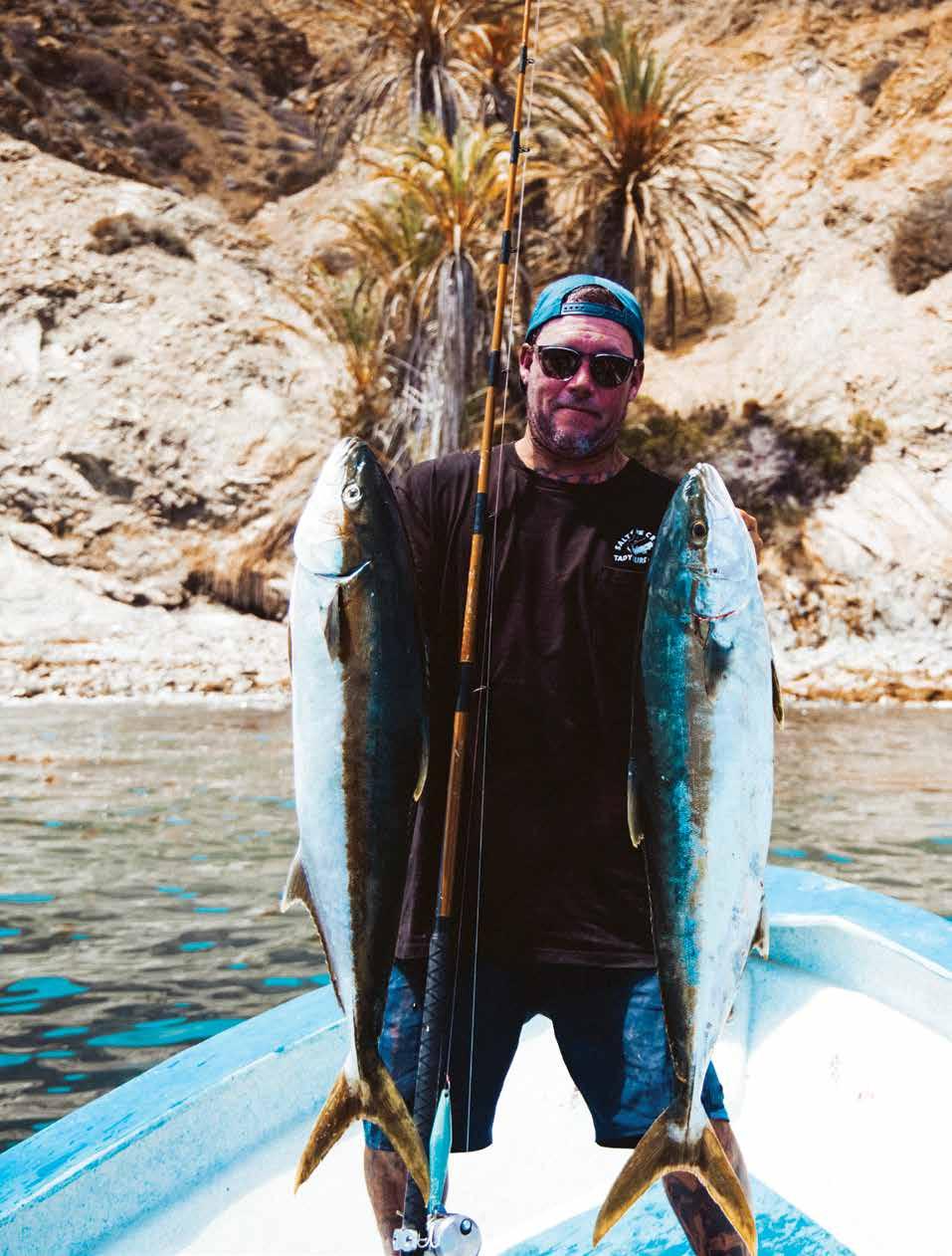
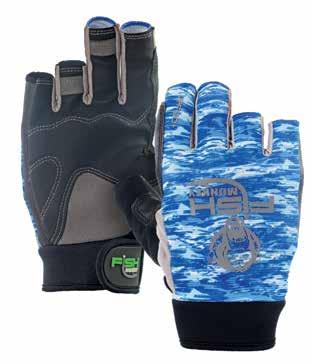
The FM15 Crusher is the ultimate all-around glove for anglers chasing fish offshore this winter. Featuring an ergonomic design, these gloves reduce hand fatigue, enabling you to maintain consistent pressure on your catch with ease. The fourway stretch, quick-dry fabric is lightweight and breathable, offering UPF 50+ sun protection for all-day comfort and shielding your hands from harsh UV rays. Reinforced padding safeguards against cuts from leader lines and sharp objects, while the synthetic leather palm provides exceptional strength and durability with a second-skin feel for optimal dexterity. The open-finger design allows for precise knot tying, bait rigging, and effortless management of rods and cockpit equipment. Enhanced with a PVC non-slip grip on the palm and fingers, these gloves excel in leadering, billing, gaffing, and handling tackle with unmatched control. A reliable alternative to sunscreen, they protect your hands while ensuring superior grip and functionality, making them an essential addition to your fishing gear.
ejtodd.com.au
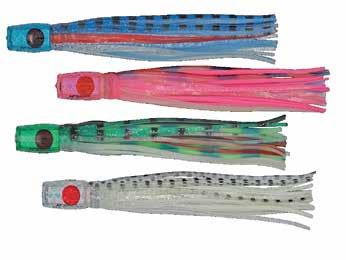
McLures has released 4 fantastic new colours in their popular Sea Monkey range. The Sea Monkey is a classic cup faced lure that is versatile and can be used in most sea conditions and from any position on the boat. These lures are deadly when the fish are feeding on smaller prey. They come with many different head colours matching the skirts with some glow heads, some tinted and some offering Kauri Shell. These lures come with most of the range offering a UV over skirt whilst the underskirt offers McLures exclusive “Luminite” (which glows in the dark on all colours). They also come with Red Crystal 3D Eyes and the resin heads are near indestructible. The Sea Monkey is 6” long overall with a skirt length of 5” and weigh 30grams. These lures are deadly on Tuna and all high speed pelagics jurofishing.com.au
The MegaBass OneTen has established itself globally as an outstanding jerkbait for a huge array of species. Now, in conjunction with renowned Japanese pro angler Shinji Sato, Megabass has developed the OneTen R+3 Hi-Float. It offers a sleek, narrow profile for quick buoyancy and will dive up to a maximum depth of one metre, thanks to its compact, rounded bill. It’s specially designed for the summer months when high water temperatures cause weeds and grasses to grow making snags and foul ups more prominent. It is effective to cast tightly around cover such as bushes, weeds, and laydowns, and around structures such as piers and rocky areas. The best retrieve method is to make two jerks and pause allowing the lure to quickly float.
vivafishing.com.au



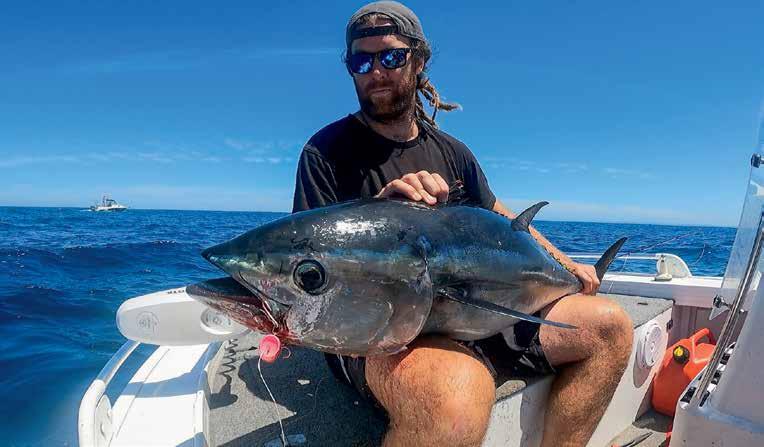
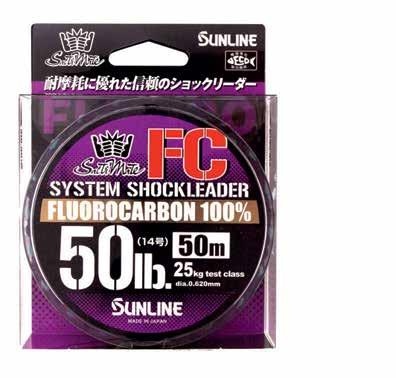
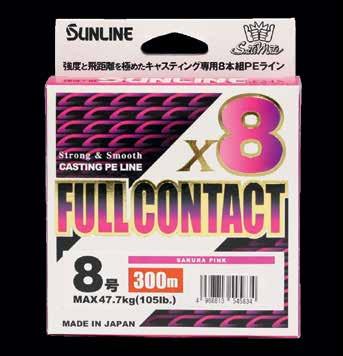
A 100% fluorocarbon leader that features high abrasion resistance and high sensitivity. The design allows for a perfect transfer of movement to your jig or lure to hook a fish. Even though it is fluorocarbon, it can withstand big shock becasue of its smooth and tenacious features. Knot strenght is excellent. Parallel spooling decreases line surface damage.
Made in Japan. Available in:
50m 12lb to 50lb.
30m 60lb & 100lb
Full Contact X8 is a high-performance PE line designed for targeting large fish like kingfish, tuna, and GT. It offers exceptional strength, durability, and smooth casting. The moderate elasticity reduces tangles, while the SAKURA pink colour provides high visibility in low light. Ideal for offshore lure fishing.
Made in Japan.
Sakura Pink 300m PE 4 to PE 12
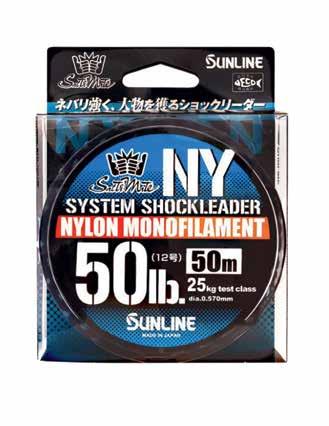
abrasion resistance, and water-repelling properties. It remains supple and easy to handle, with excellent knot strength. The leader absorbs shock from strikes and hook sets, preserving lure movement offering tenacious performance to land big fish.
Made in Japan. Available in: 50m 4lb to 150lb.

The Bottom Worm Longshank is a micro version of Vexed’s Bottom Meat, designed for light gear and smaller inshore species. It can be jigged on its own or used as a “fish-catching sinker” at the base of a paternoster rig. Testing on sand and King George whiting showed more bites on the Bottom Worm than the dropper hook. Featuring a sharp BKK longshank and durable scented worm, it’s ideal for presenting soft baits like pipi, squid, worm, prawn or mussel. Available in 3.5–130g weights and hook sizes from #10 to #1, it suits boat, beach, estuary and river use. Effective for jigging or slow hopping for species like bream, flathead and whiting. vexedfishing.com.au
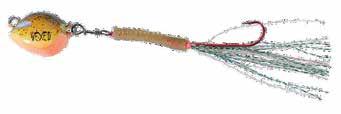
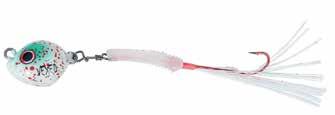
Built for precision, this 6’11” Medium Heavy baitcast rod was crafted specifically for throwing jerkbaits – especially our own Samaki Redic range, trusted by tournament anglers targeting impoundment barra up north. With a mod-fast action and a casting weight sweet spot of 1/4 to 3/4oz, this rod delivers the perfect blend of responsive action and casting control needed to work a jerkbait properly. Constructed with advanced carbon blank technology, it offers exceptional strength without the bulk. Outfitted with Fuji K Alconite guides and a minimalist ash EVA grip, the SZX6111BMH-MF balances refined design with real performance – built to dominate NQ’s freshwater heavyweights. samaki.com.au
If you’re chasing big fish with heavy drag pressures such as marlin, tuna and swordfish then you need a hook that’s both sharp and extremely strong. The new Trokar Circle from Eagle Claw offers exactly that and has been designed to confidently target and land large game species. The most impressive aspect of the Eagle Claw TroKar TK619 Offset Circle Hook is the surgically sharpened point. Never before has a point this sharp and durable been achievable on such a heavy wire diameter. Designed and manufactured in Denver, Colorado, the surgically sharpened point of the Eagle Claw TroKar TK619 Offset Circle Hooks gives anglers 50% faster, deeper, surer penetration with every strike. The three facets of the TroKar point are precisely and symmetrically ground for top performance, using Eagle Claw’s unique Surgically Sharpened Technology - no other brand of hooks in the world are made with this technology.
tacspo.com.au


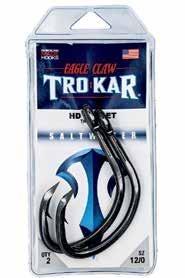
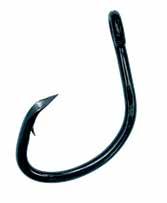
The Fishcraft Stick Dog is built for explosive topwater strikes. Whether you twitch it tight, sweep it long, or rip it hard, this lure responds with unpredictable surface action that draws aggressive hits from pelagics hunting over the reef. Its erratic movement, loud internal rattle, and highvis colours make it easy to spot and hard to ignore. Equipped with 5X strong treble hooks, you can rest assured that when those giants strike, you’ll be locked in – for better or worse. Available in 160mm and 180mm. samaki.com.au
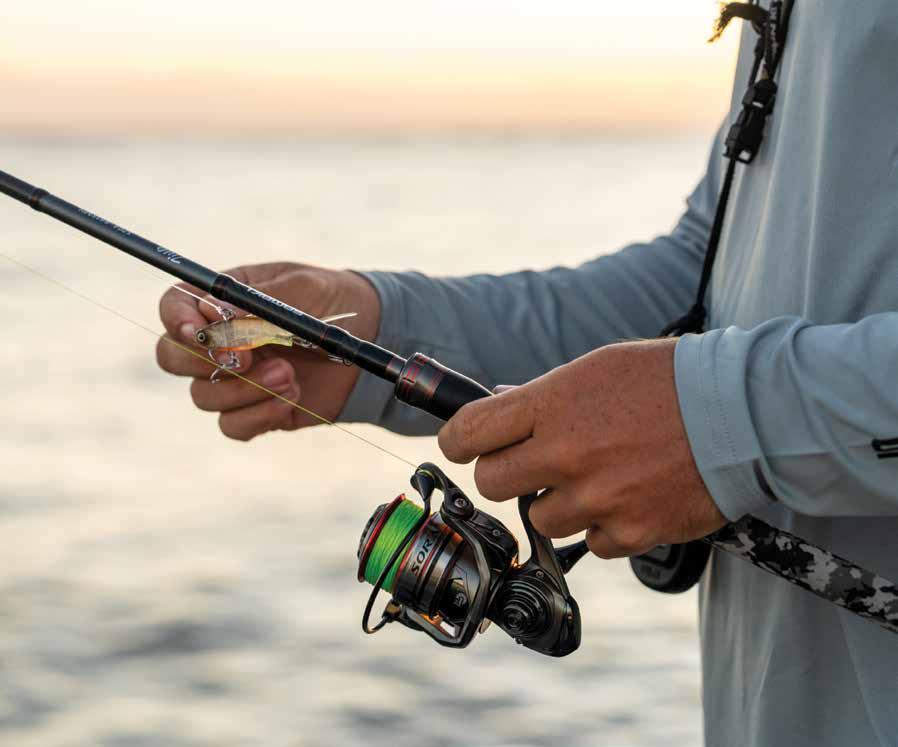
The 4th Generation Zing Series pushes performance further with:
> HyperKinetic Nano+ Fibre Graphite Blanks for enhanced sensitivity and power
> Fuji Concept “O” Guides for seamless line flow
> Samaki Exclusive Ergonomic Reel Seat designed for comfort
> Signature Camouflage Hard EVA Grips with Red Highlights for a firm hold
Designed for Estuary, Inshore, Travel, Egi, and Surf, the Zing series now features species-specific models in 7’2”, 7’4”, and 7’6” lengths.
Engineered for durability and smooth operation, the Sora Spinning Reel features:
> Micro-Adjustable Carbon Fibre Drag for ultimate control
> Triple Anodized Aluminium Spool for longevity
> Sealed Stainless Steel Ball Bearings ensuring fluid performance
> Machined Aluminium Handle & Brass Pinion for strength and reliability
> Gold Anodized Line Roller & Waterproof Drag for added protection
Available in 2000, 2500, 3000, 4000 & 5000 sizes, the Sora is ready for light estuary to inshore battles.

Mercury Marine has officially opened its new state-of-the-art Training Centre in Dandenong South, Victoria—the company’s first of its kind in the Asia-Pacific region. Purpose-built to elevate technical excellence, the facility is designed to upskill marine technicians with the expertise and confidence needed to service the latest Mercury technologies. Delivering a fully immersive, hands-on learning experience, the centre focuses on Mercury’s cutting-edge outboard and MerCruiser engine systems. Trainees receive in-depth instruction in diagnostics, electrical and propulsion systems, and engine maintenance, guided by Mercury’s expert trainers. The space is modelled on a premier-standard Mercury service centre to ensure technicians are job-ready. Technicians work with the full product range— from portable engines to V10 and V12 outboards—using the latest diagnostic tools. With small class sizes capped at 12, each participant benefits from personalised attention and maximum hands-on time. The facility reinforces Mercury’s commitment to premium support across Australia and beyond. mercurymarine.com

After two years of rigorous development and testing, Gaff-Mann proudly presents the Pro Series, a ground-breaking innovation in gaff technology. Designed to be remarkably lightweight yet exceptionally strong, these gaffs redefine what anglers can expect from their fishing gear. Crafted with precision, the Pro Series boasts a structural grade aluminium handle that is fully anodized for durability and corrosion resistance. Featuring three evenly spaced grips, this gaff provides optimal control and handling in any fishing situation. But what truly sets the Pro Series apart is its unique ability to float. Gone are the days of losing your gaff to the depths below in cases where it may be dropped overboard. With a total weight of just 0.9kg (900g) and a length of 1450mm, these gaffs offer unparalleled buoyancy without sacrificing performance. Available in a range of sizes tailored to target tuna, sharks, and kingfish, the Gaff-Mann Pro Series is the ultimate companion for any angler seeking reliability, versatility, and innovation on the water. Elevate your fishing experience with the Pro Series gaffs and discover the difference for yourself. gaffmann.com.au

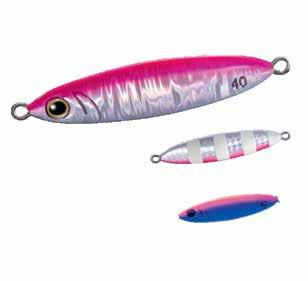

Shimano Coltsniper Wonderfall jigs are a shore jigging style lure designed to have a captivating fall action that allows you to target a variety of fish species around the Australian coastline. Available in 30, 40, 60 and 80 gram sizes and five different colours featuring SCALEBOOST technology that give them complex reflections in the water like the scales of a real baitfish to attract strikes from even the most keen eyed predators.
shimanofish.com.au
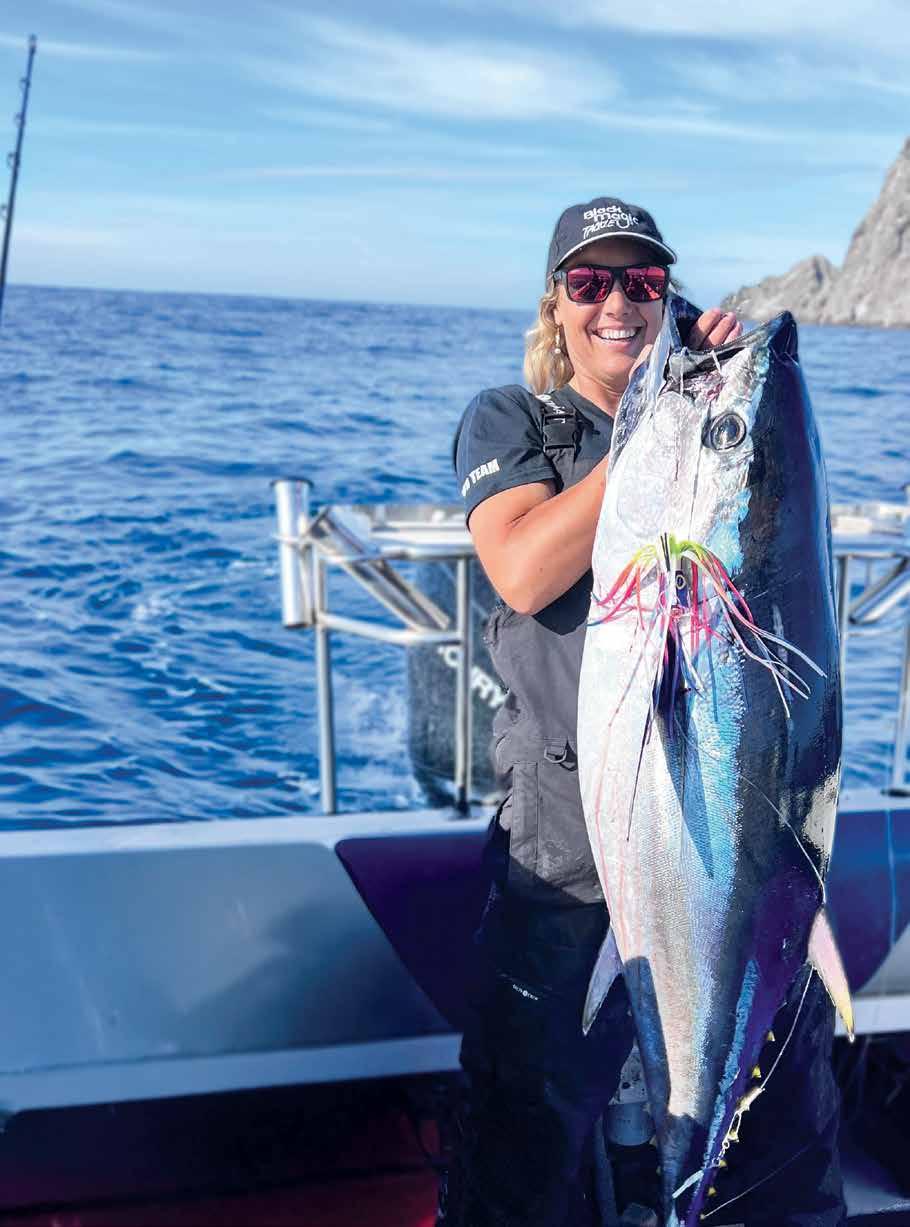

Our latest innovation in game lures, the Jonah’s Kona XT, does all the things you want it to, it swims erratically, it has a pronounced wiggle, and it creates an impressive smoke trail. And most importantly it catches tuna. Big tuna, small tuna, and all the tuna in between. Show your mates how the experts do it. Troll a 6” or 8” Jonah’s Kona XT this SBT season.





Don’t expect a fair fight when you tangle with a mangrove jack… but it’ll be memorable.
Words & Images: Sam Gilchrist


The bronzed, gorgeous red – and sometimes downright dirty brown – flash of the flank is, if you’re lucky, all you might see of the fierce, ferocious, and utterly unflinching mangrove jack. That flicker of colour as they retreat into their lair is often the only glimpse you’ll get before you’re left with a shredded leader, a busted ego and the growing urge to go back for more.
These fish aren’t just tough – they’re downright hostile. They don’t fight clean. They don’t give you a moment to compose yourself. The moment you hook up, you’re in a straight-up ambush, a brutal battle in tight quarters, where any mistake is punished instantly. They’ll run you straight back into twisted mangrove roots, oyster-encrusted rock ledges or the closest man-made structure, snapping braid, burying hooks and leaving you in stunned silence with only a frayed tag end to show for your efforts.
It’s a fight that’s over in seconds, often before it’s even started. But that’s the game. That’s the high. And once you’ve experienced it – once you’ve been absolutely monstered by a red dog from the shadows – you’ll be obsessed. It’s not just about catching them. It’s about trying to beat them at their own dirty game. They’re cunning, territorial and explosive. From the tight timber and snagridden mangrove creeks to deep estuarine rock bars and even offshore haunts, the jack shows up where you least expect it, hits like a hammer, then vanishes before your brain can process what just happened. And if you do somehow win the brawl and bring one boatside, don’t think the danger’s over – they’ll bite, they’ll bark and they’ll make you think twice about putting your fingers anywhere near those jaws.
In this article, we’ll dive headfirst into the addictive, white-knuckle, gear-testing, angler-breaking pursuit that is chasing jacks. It’s intense. It’s raw. It’s fishing at its absolute best.
As the name suggests, mangrove jacks haunt coastal mangrove systems. From Coffs Harbour in NSW, right around the tropical top of Australia, and down to about halfway along the WA coast, these fish hold dominion. But don’t be fooled – their name doesn’t do justice to their adaptability. These brutish, bronze assassins show up in a huge range of habitats.
Their favourites? Let’s start with the coastal mangrove systems – particularly those with deep root networks, submerged logs and yearround structure. Jacks are territorial thugs. Once they pick their patch, they don’t like to leave. A good log might host a bruiser for an entire season.
Then there are estuarine rock walls and coffee rock ledges. These areas are absolute jack goldmines – especially when the current is pumping. Don’t be surprised if you find yourself tangling with a big mulloway in these areas too; they’re a common and very welcome by-catch.
Pontoons, jetties, wharves, bridges, oyster leases – any hard man-made structure can hold jacks. They’re drawn to these ambush zones like moths to a flame. Offshore reefs, rocky islands, caves and headlands also come into play. You can even find jacks on the flats if the conditions line up – yes, flats fishing for jacks is a thing! Get the tide and timing right and you can enjoy explosive topwater eats on walk-the-dog lures and small poppers under moonlight. Reflecting on some of the times I’ve been dusted offshore while chasing snapper, it felt like the same level of punishment that a jack deals out –swift, brutal and final. You don’t forget those moments in a hurry.
Jacks are wired for violence. Their aggression makes them a dream for the keen lure angler – although ‘dream’ may not be the right word once you’ve had a few lures torn from your soul and wallet. When it comes to lures, they’ll hit a variety of styles – soft plastics, jerkbaits, paddle tails, topwater, hardbodies –but make no mistake: success depends on cast accuracy. You need to deliver your offering into the danger zone. Snags, shadows, rock crevices – if you’re not snagging up through your day’s fishing, you’re not in the game.
Twitching jerkbaits such as the Daiwa Double Clutch or Jackall Squirrel 79s and 115s tight to cover is absolutely deadly. Cast long, twitch hard and most importantly, pause.
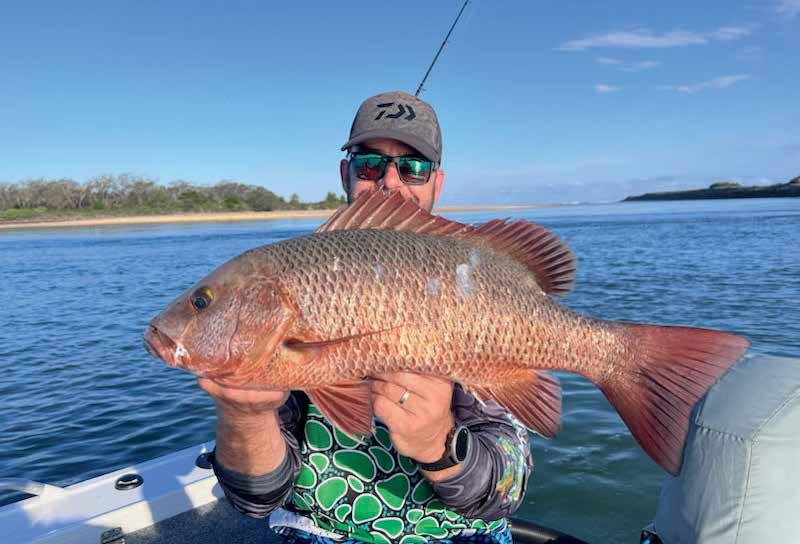
Long pauses often trigger vicious strikes. These same jerkbaits also perform well along rock walls in lower-current conditions where you can properly control the twitch-pause cadence. Paddle tails in the 5in range are another top-tier option. The trick is in how you rig and fish them. Rig weedless on a 3/0 to 5/0 hook and skip them deep into the timber. Let them sink, then twitch or burn them out. Some of my best bites have come from just slow rolling them with a subtle rod twitch – essentially running them as a topwater sub-surface hybrid.
Fishing deeper? Rig your plastics on 3/8oz jigheads. Adjust sink time and retrieve speed each cast. Some days they’ll nail it on a fast burn, other days a slow roll and pause does the trick. Be versatile – stay alert to patterns as they emerge.
Topwater, though… that’s the dream. Poppers, fizzers, stickbaits, walk-the-dog styles, even weedless softies – jacks love smashing topwater presentations. It’s about selecting the right lure and retrieve for the mood of the fish. One day a fizzing commotion will fire them up, the next it might take a subtle sideto-side walk the dog to draw a reaction. Trust your gut, lean into your instincts and fish with intent. You’ll go many casts without reward, but when the hit comes, it’ll be explosive –and worth the effort.
The battle is won or lost in the first three seconds. Full stop. The jack doesn’t hesitate. It eats and bolts – right back into its lair. You must be ready. Hook set hard and fight ugly. Forget finesse – this is close-quarters hand-tohand combat with heavy drag. A jack typically strikes as it turns back into its hidey-hole, so your window to respond is tiny. Reaction time, tackle strength and aggressive technique are all essential. Set your drag just below full breaking strain of your line and be ready to
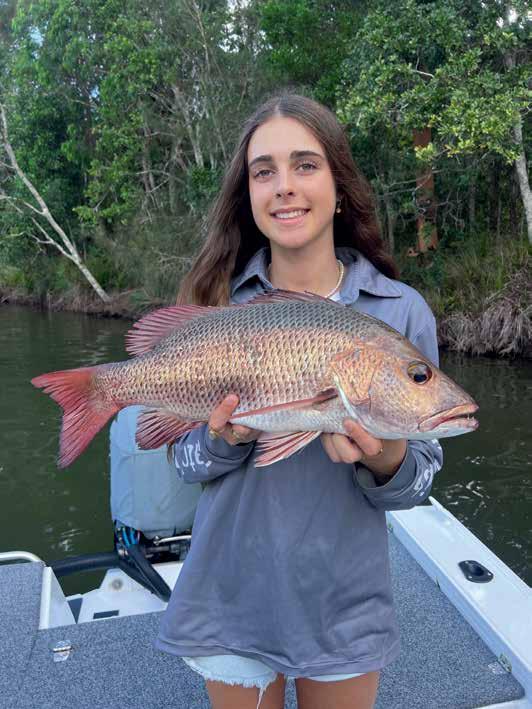
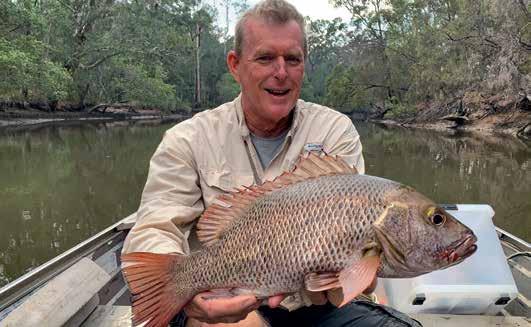
thumb the spool. Locked drag systems can fail, but fish too light and the jack will simply destroy you. You must remove them from the structure immediately. Lift, wind, rip –whatever it takes. Fail to turn their head and you’ll be left with a frayed leader and a story of what could have been.
Once clear of danger, you can back off and enjoy the fight. They rarely make big runs once out in open water. But the opening exchange? That’s where legends are made.
You don’t need a hundred rods, but you do need the right tools. I fish fast action rods in the 8kg range armed with quality 4000 reels in spin and 100 size in overhead. I spool with 30lb-50lb braid and use the heavier outfits for the heavier structure. Leader is 25lb when in open water and up to 60lb when in heavy structure.
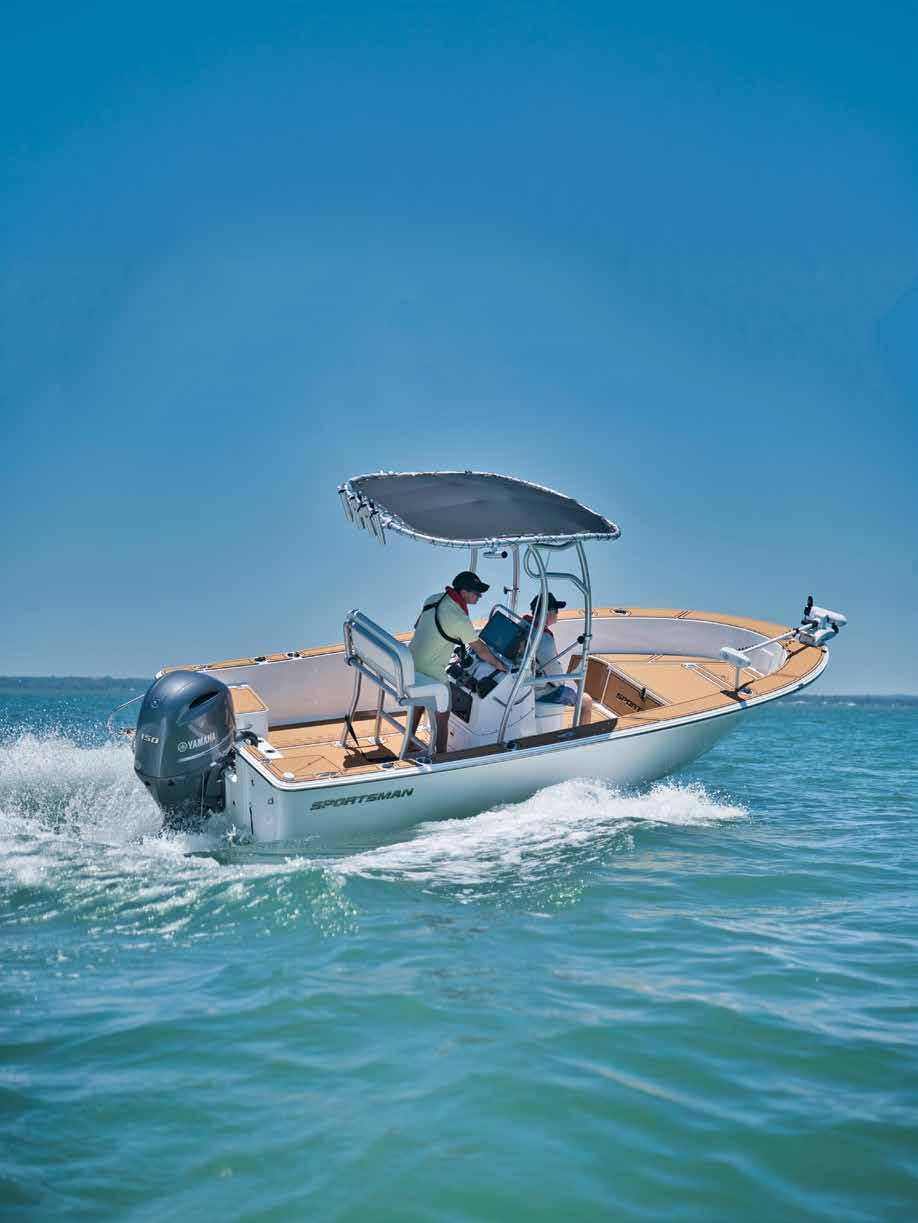


Select your rod and reel based on lure type, structure density, and expected fish size. Shorter rods are better in tight mangrove terrain or around pylons. Longer sticks work best for casting heavier swimbaits around oyster racks or along rock walls.
I specifically use a Daiwa Battler Direwolf paired with a Daiwa Zillion, a TD Black Gongbeater and TD Black Duckfin paired with a Daiwa Tatula 100 and 200, and the Saltiga LC S75-PE 1/2.5 with a Daiwa Certate 4000 ARK. This is all quality gear. The rods have fast actions, excellent recovery on the cast for accurate casting and they can dish out the hurt.
These are fish that are worth investing in, everything from line and leader to trebles and split rings need to be ready for that first strike and dogged fight.
You will lose more jacks than you land – that’s just how it goes. But when the stars align and you extract one from its lair, the feeling is unbeatable.
The bites come from nowhere. Sudden. Brutal. Often unforgiving. Stick with it. Every defeat takes you closer to a victory.
Also, a friendly warning: jacks will bite you! They bark, snap and lunge even in the net. Be careful when unhooking or holding for photos – those jaws aren’t just for show.
Jacks are bulletproof and make brilliant catchand-release targets. They handle the process well and deserve our respect.
That said, they’re also incredibly good on the plate. Their flesh is firm, white and delicate with a lovely flavour. Keep one or two a season
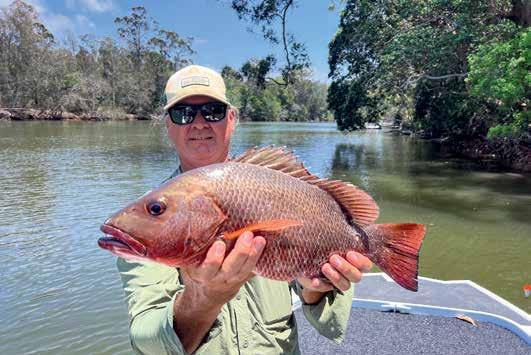
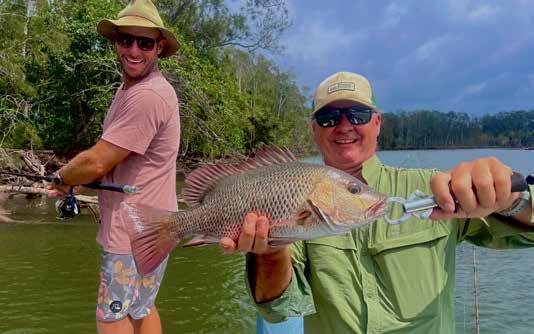

if you like, but be selective – don’t over-harvest and always care for your catch properly. Dispatch quickly, bleed and get it straight on ice.
Cooked up in a mix of flour, curry powder, salt and pepper, and fried in a pan, jack fillets are next level. Try it – you’ll be hooked.
Jacks are the genuine thugs of our tropical estuaries. Brawlers. Enforcers. The creek bikies with attitude and teeth to match.
Chasing them will test every part of your angling game. You’ll lose tackle, you’ll lose fish – but you’ll never lose the buzz. So, tie on something dangerous, check your drag, and cast deep. The red dogs are waiting.



Toray Super Strong PE F4 is an ultra-reliable 8-strand braid with superior strength and shock absorption. Its unique construction enhances durability and sensitivity, making it ideal for baitcast setups. Featuring a multi-coloured pattern for depth tracking, this premium Japanese-made line delivers precision and control.
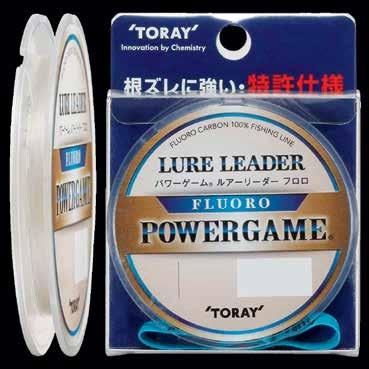
Toray Power Game Lure Leader is a next-generation 100% fluorocarbon shock leader designed for all fishing styles. It offers exceptional impact resistance, ideal stiffness, and superior abrasion resistance, making it perfect for rocky terrain. Available in a 30m spool with an elastic band.
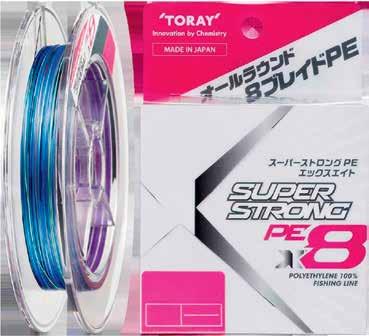
Toray Super Strong PE X8 is a smooth, supple, and ultra-strong 8-strand braid designed for precision jigging and twitching. Its round profile enhances casting, while abrasion resistance ensures durability in snaggy terrain. The five-colour design aids distance control. Available in 200m spools.
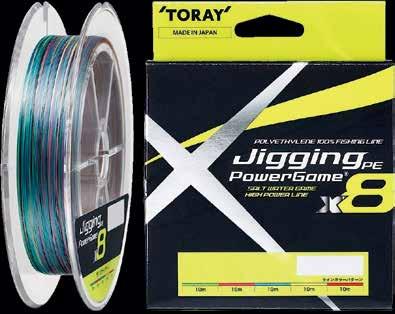
Toray Jigging PE Power Game X8 is a premium Japanese-made 8-strand braid designed for all jigging styles. Its special resin coating enhances abrasion resistance and smooth jig descent, while a five-colour pattern aids depth control. Also suitable for casting, it’s built for serious offshore anglers.
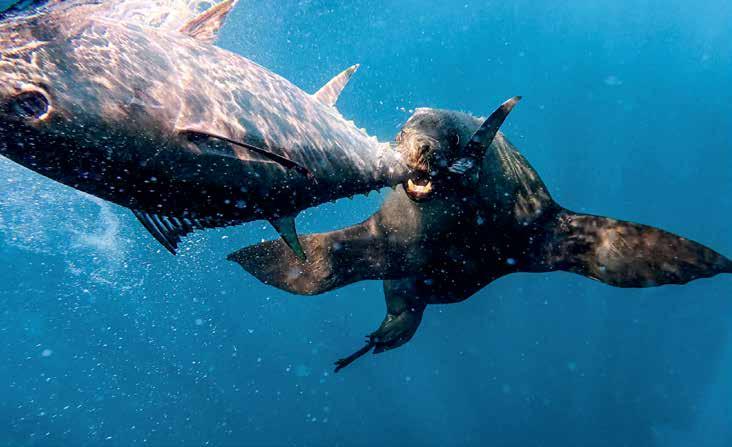
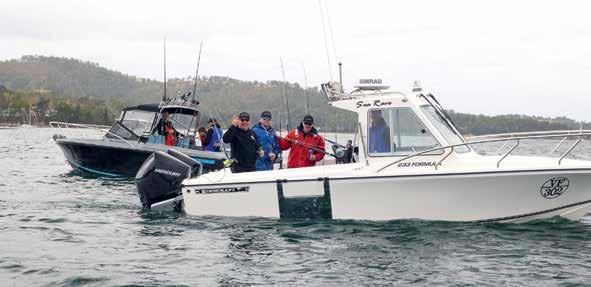
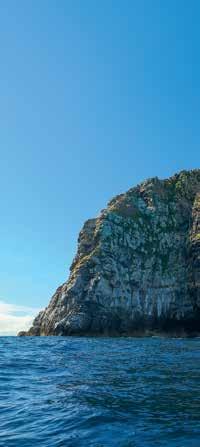
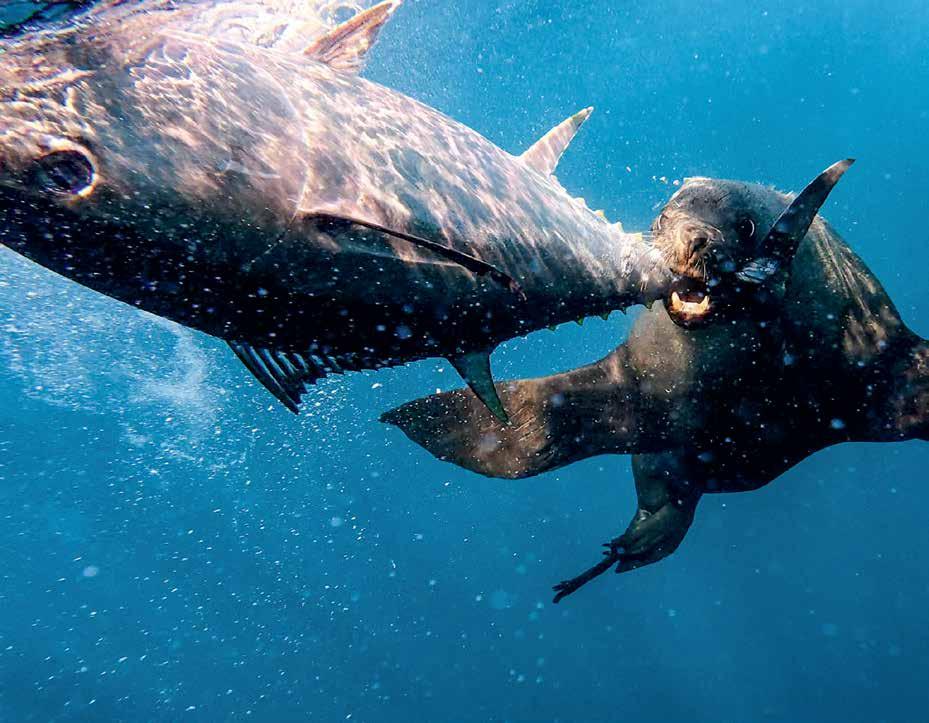
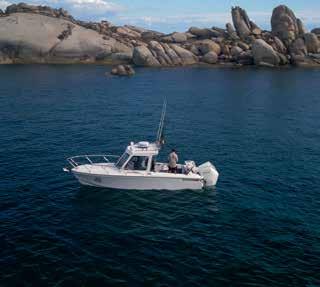
Catching big swords, southern bluefin tuna and striped trumpeter in breathtaking scenery is about as good as it gets for this bunch of devotees.
Words: Joel Ryan Images: A Full Crew
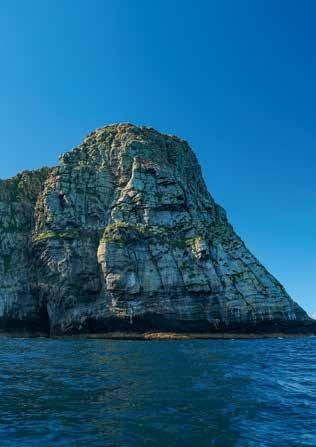
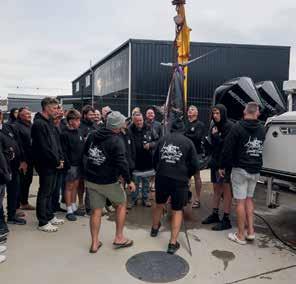
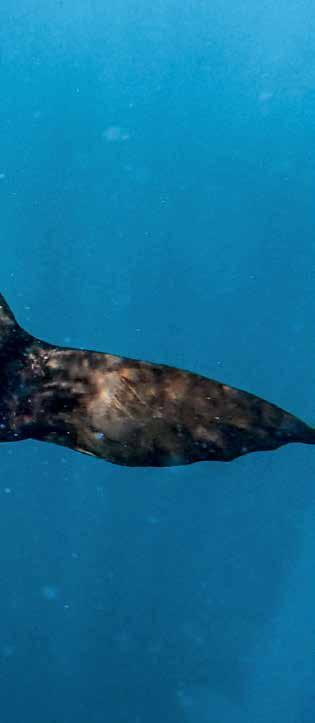
Each year, Edencraft rallies a fleet of passionate owners and their legendary Formula boats for a full-throttle expedition into some of Australia’s most remote and challenging waters. The mission: Tasmania. More specifically, chasing tuna, swords and striped trumpeter around this wild island state.
It all kicks off in Geelong, where a growing convoy of tough rigs and tough boats rolls into port for the overnight crossing aboard the Spirit of Tasmania. Each trailer carries a 233 or a 255, packed to the gunnels with gear, fuel, food and fishing dreams. Squeezing a dozen of these into the belly of the ship is no small task, but somehow it gets done, every time.
And it’s worth it – because trailering down opens the door to everything. Tasmania’s weather is famously fickle. Having your own boat behind your ute means you’re mobile. You can tow across the island to chase a
better forecast, follow the bite, or shoot down a rabbit hole the locals tip you off about the night before. It’s this flexibility that makes the whole trip click. Over 10 days, we clocked more than 1,500 kilometres by road – but not a single lay day on the water. For a trip built around open ocean and tight weather windows, that’s rare.
This year’s trip kicked off with a bang – and a serious one. While most of us were still rolling off the ferry and sorting out trailers, one of the Tassie crews had already splashed their new 255 and steamed wide for a sword drop.
Brady Free hadn’t even owned the boat a month, and this was their first proper go at a daytime sword. As we unpacked in the car park, the messages started flying in. “Hooked up.” “Still fighting.” “Big fish.” Phones were lighting up as the battle stretched past the two-hour mark. Then came the shot: a huge swordfish draped across the deck of the 255 – 204 kilograms of angry blue, chrome and bronze. A monster, and a hell of a way to welcome the mainland crew to Tasmania. The tone was officially set.
With everyone fired up, the next objective was clear: southern bluefin. We trailered to Dover in the south and launched into a calm window that let us push wide to Pedra Branca – a jagged spike of rock nearly 300 metres high that juts out of the Southern Ocean like a tombstone. It’s 70 clicks offshore and fully exposed. Get caught out here in a bad blow and you’ll cop it – but today, it was pure magic.
From the moment we set lures, the action was thick. Single lures off the transom barely got wet before getting slammed by 25 to 30 kilo fish. It was almost too easy. There were bigger models deeper in the schools, but getting a lure past the mid-size fish was almost impossible.
Still, we weren’t complaining. Hook-ups were constant, reels were screaming and smiles were wide. For a crew that had just driven, ferried, and towed for three days – it was everything we came for.
Of course, nothing’s ever that simple. Pedra Branca’s resident fur seals have the whole game dialled in. The second a rod loads up, they’re off the rock and into the water. You might fight a tuna for ten minutes, working it to the boat, only to watch a 200kg seal rise beside you with the fish hanging from its mouth. It happened repeatedly. Absolute carnage.
Closer to the rock, we started seeing some bigger fish busting up. The divers pushed through the thick schoolies and landed bluefin in the 60 to 70 kilo range. One fish was called at 120 kilos – the kind that bends you double and breaks your will.
But if the seals saw it, you could forget about it. Sometimes you’d fight to within metres of the boat, rod fully loaded, colour swirling under the surface – and then a blur of grey fur would shoot up and it was game over. All part of the Pedra Branca experience.
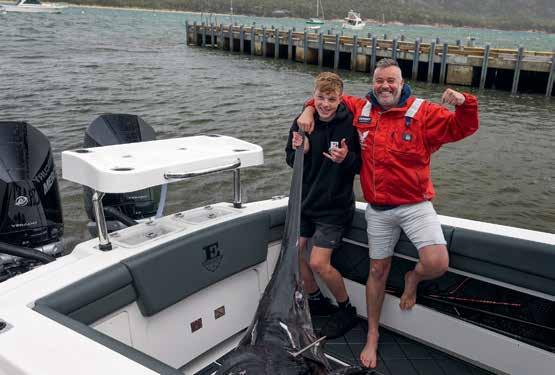
Next stop was the Maatsuyker Islands group –the southernmost point of Australia. Towering cliffs, windswept slopes, and savage, beautiful terrain. The kind of place that makes you feel small.
Here the tuna were stacked even thicker, and the seals were just as ruthless. So we changed tack and dropped jigs and baits in search of something Tassie is famous for: striped trumpeter.
What surprised us was the depth. We’d expected 80 to 100 metres. But we were hooking them in 20 to 30. And they were quality fish – heavy, stubborn, and seriously tasty. Getting them to the surface was another battle. Some of the bigger fish came up solo and clean. Others? Not so lucky. Seals were on the prowl, and we lost more than a few midretrieve. The trick ended up being doubles – two fish hooked at once. Land one and sacrifice the other. Brutal, but effective.
Some of the stonkers that hit the Vexed jigs were unstoppable, busting us off on the bottom without a chance. It was humbling, frustrating, and bloody exciting all at once. Some of the boys went the jigging route and got absolutely smoked by fish grabbing metal and tearing off before they could even lift. We lost jigs, leaders, tempers – and fell in love a little more with Tassie’s bottom fishing.
Next up was Eaglehawk Neck – a location we’d all been itching to hit. Rugged cliffs, deep canyons and serious pedigree when it comes to swordfish and jumbo tuna.
The weather wasn’t perfect, but it was do-able. The sword grounds are only 30 kilometres offshore, a short run by Tassie standards. So, we geared up, stitched our
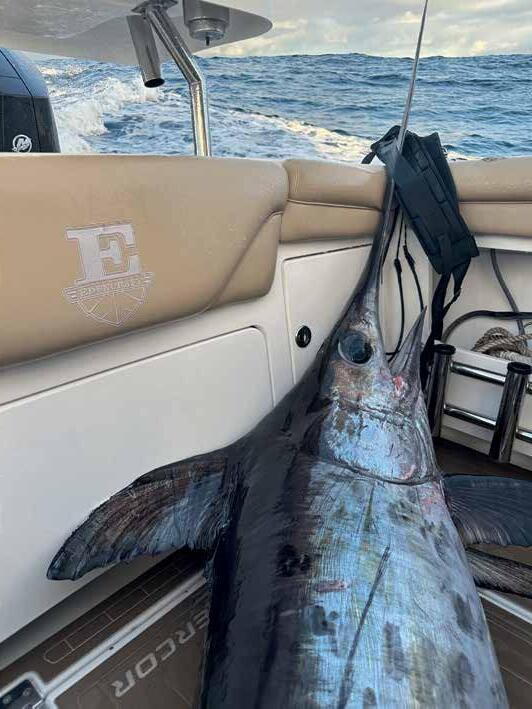
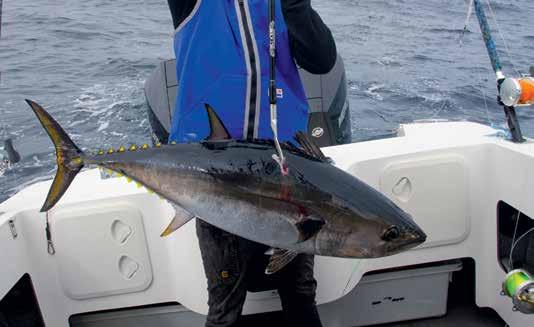
squid, and headed deep. First drop – tight. But we pulled the hook close to the boat. Next drift – same story. And again on the third. Circle hooks are brutal like that. When they work, they work. When they don’t, you’re left yelling at the clouds. But we’d seen enough. The fish were there. The next day, with lighter winds and better angles, we went all-in.
This time, it stuck. The take was subtle –just a little line lifting off the surface. Then it arched, then it ran. A long, heavy fight followed, punctuated by big, stubborn dives. But eventually, the fish came boat-side and slid into the 255. Sword on deck. Not far away, another boat – Mariana J – were celebrating their own first sword. Two fish, two boats, one epic Tassie canyon. The smiles said it all. We pulled the pin with a sunset

www.meridiantackle.com.au
Designed with a longer tubular hood to better protect your bait, Meridian Tackle Sword Skirts suit squid, mackerel, salmon, tuna and more. Made from tough, durable material to withstand bait-stealing bottom fish and deep-sea conditions, they’re available in two sizes to match your bait perfectly. Easy to rig, charge and fish, they’re loaded with luminescent and UV properties to attract swords from the deep. Charge quickly under sunlight or even faster with a UV torch. Available now in your favourite Meridian colours.


backdrop, cold beers and that rare feeling you only get when a plan actually works. Tasmania was turning it on.
With only a few days left, we pointed the rigs north and aimed for Bridport – the launch point for a full-blown Bass Strait crossing to Flinders Island. It’s remote, rugged and raw. The island itself is breathtaking – big granite hills, sandy bays and that unmistakable feeling of being far from everything. The kind of place you could get lost in for weeks.
We fished hard off the east coast, targeting striped trumpeter and scouting for cray spots. The divers dropped into huge ledge systems covered in kelp and loaded with life.
The crays were patchy, but the ones they found were next-level. Proper Tassie bulls – thick, dark red and heavy in the hand. One diver surfaced laughing through his snorkel, cray claws wrapped halfway up his arm. “This thing’s as big as my dog,” he yelled. Fair call, too.
That night, we stayed on Flinders and hit the pub. After a week of fighting fish, dodging seals and chasing weather, the beers hit different. The locals were legends, the steaks were thick, and the stories got better with every round. It was the kind of night that makes you forget how tired you are — until you roll into bed and don’t move for nine hours.
Our final dive was back in Coles Bay. The sun came out, the winds dropped off, and we made a lazy run around to Wineglass Bay — surely one of the most stunning places on the planet. The water was gin-clear and alive with fish.
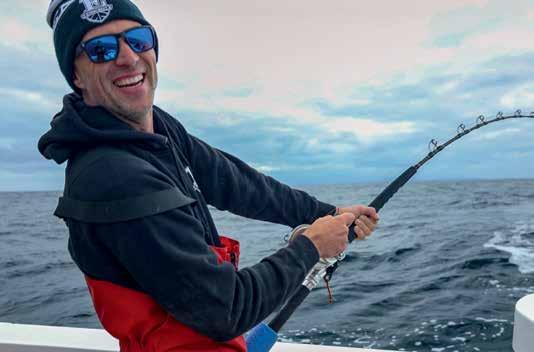
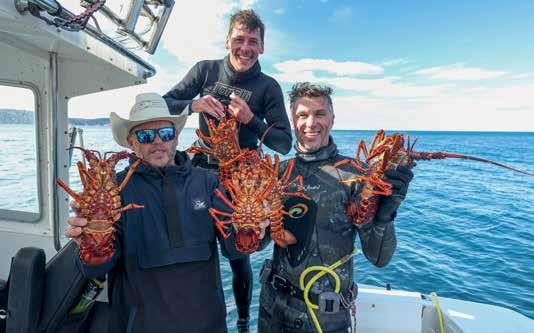
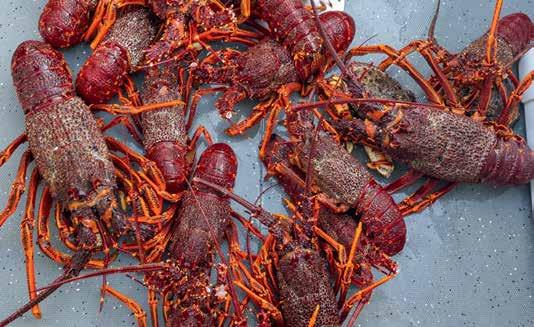
We dropped in and found ledge after ledge crawling with crays. Big ones, too. More than we’d seen all trip. It was the perfect way to wrap things up — clear heads, full bags, and Tassie in all its underwater glory.
Back on the mainland, we rolled off the Spirit and pointed the utes towards home. Saltstreaked boats, diesel tanks empty, but spirits full. Every one of us was buzzing. Over ten days, we hadn’t missed a beat — just fishing, diving, exploring and laughing our way through one of the best places on earth.
And that’s what makes a great trip, awesome boats, good mates, and go places most people only dream about. Tassie delivered in every possible way.





9.5”


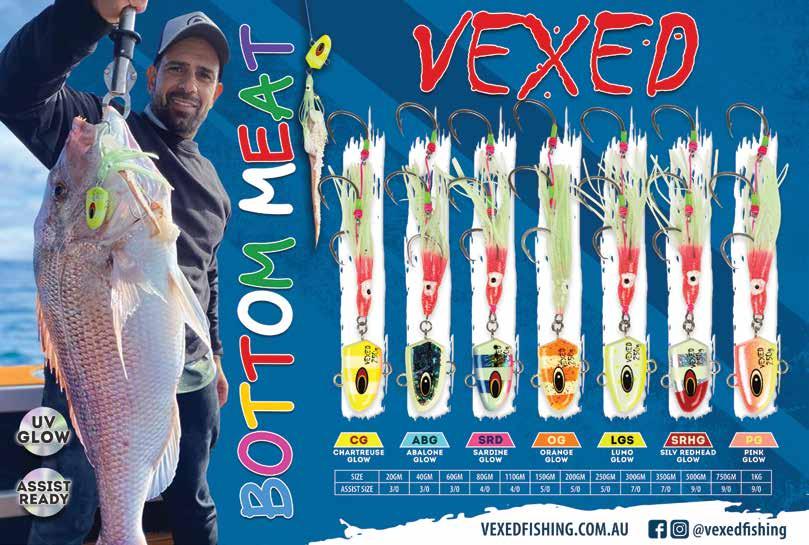

This unspoiled coastline has a huge range of shore options.
Words & Images: Jamie Crawford

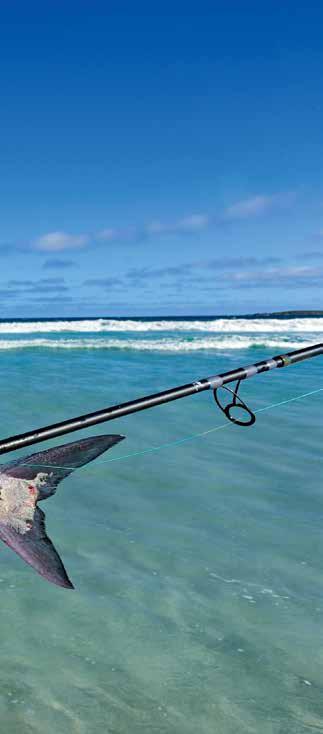
Kangaroo Island, lying off the southern tip of the Fleurieu Peninsula, is one of South Australia’s premier tourist attractions – and for good reason. The island offers unspoilt coastline, dense bushland and abundant wildlife. Even since the devastating bushfires of early 2020, the island vegetation has now rejuvenated, with healthy scrubland and forested areas encircling the pasture and cropping lands. Kangaroo Island, or ‘KI’ as it’s affectionately known, is the third-largest island in Australia, after Tasmania and Melville.
Lying 14km off the mainland, the island’s north coast cliffs rise starkly from the waters of Backstairs Passage. The island spans some 155km from Cape Willoughby in the east to Vennachar Point in the west, and boasts an incredible 520km of coastline. This coastline consists of some amazing beaches, bays, headlands, rock ledges, coves and rivers, most of which are often bordered by thick mallee scrub and eucalypt.
There are two ways to reach the island. The first is to take the SeaLink Ferry from the Cape Jervis terminal across to Penneshaw, which takes around an hour. This is the only means of getting across to the island with your own car. You can also tow a caravan or boat onto the ferry, but bear in mind the fare when towing becomes very expensive. Alternatively, you can park at Cape Jervis and travel on the ferry as a passenger – provided you have a means of transport once you arrive on the island. You will need to book tickets in advance for the ferry, and during peak holiday time the two SeaLink ferries are regularly booked out.
The second option is to fly from Adelaide Airport to Kangaroo Island. Qantas and Regional Express offer flights to Kingscote, which take around 30 minutes from Adelaide. Budget and Hertz offer rental cars once on the island.
Because of the logistics and cost involved in bringing your own boat to the Island, most visitors opt for land-based fishing, and to be honest there are more than enough shorebased options to satisfy a fishing holiday, with plenty of surf fishing, estuary, rock and jetty options dotted around this beautiful island.
There are multiple rivers cutting through KI’s landscape, which range from small coastal inlets to more significant rivers that are popular with kayakers and some even navigable in small dinghies. Most of the river mouths silt over during the dry months, with decent winter rains flushing these systems and opening the mouths to the ocean.
Most of these rivers offer good estuary fishing in the lower reaches, which usually extend for a kilometre or two inland before narrowing and becoming quite shallow. Some notable rivers on the island include the Cygnet, Harriet, South West, Middle River, Western River, Eleanor and the Chapman.
All these rivers offer salmon trout and mullet, but it’s the resident bream which are the most sought-after. The bream numbers in these rivers are essentially good, but sometimes small bream are over-represented in some waterways, creating underdeveloped populations. But don’t worry; some big bluenosed bream still lurk in these rivers, you just need to adopt tactics to weed out the smaller fish.
There’s isn’t much in the way of man-made structure in these rivers, but there are plenty of natural snags, rock bars and overhanging vegetation. Fishing soft plastics hard around the snags and casting up underneath overhanging branches will find some of the bigger bream, especially around the sweeping river bends. When casting soft plastics, light
jig heads in the 1/16 to 1/32oz are the go, with curl tail plastics in the 40 to 60mm range effective, along with small 35 to 50mm suspending hard-bodies.
Bait fishing can be very successful in these rivers too, with larger baits such as pilchard tails, strip baits from salmon trout and bigger green prawns helping to weed through the small fish. I prefer using circle hooks or shiner pattern in size 2 to 4 to lower the chances of gut-hooked fish. A light leader of 10lb fluorocarbon and a small pea sinker will complete the set-up.
There are some amazing beaches on KI, from high-energy coastlines to sheltered stretches of sand. The high-energy beaches of the south coast include Pennington Bay, Vivonne Bay and Hanson Bay, with medium energy beaches including Stokes Bay and Snellings Beach positioned on the north coast. The good thing about beach fishing on Kangaroo Island is you can pick which coast to fish depending on the wind direction. Southerly winds offer offshore conditions when fishing along the north coast, while northerly winds are preferred when fishing the south coast. And with a mere halfhour drive separating the two coasts, it’s easy to switch between the two.
Big Australian salmon patrol the surf line along these beaches, pushing into near-shore gutters to feed during the building tide. When the conditions are right, schools of salmon can be spotted in the surf, and the lure fishing can be hectic at these times. Aside from lure fishing, casting baits into the deeper holes can be very productive, with salmon of varying size, big tommy ruff, silver trevally, flathead, mullet and school whiting all active along the beaches of KI. Fishing around the high tide is preferred, especially when it coincides with late afternoon.
Fishing into the night can bring some good results with tasty gummy sharks and school sharks on offer, along with bronze whalers. Some big bronzies patrol the beaches around KI – and can offer some great sport if chasing big sharks is your thing. Mulloway can be caught around Kangaroo Island on occasions, too, but they are very sporadic and hard to specifically target.
There are plenty of sheltered beaches around KI that offer good fishing for bread-andbutter species, especially in the north-east corner of the island. Here some nice flathead, mullet, salmon trout and occasional King George whiting can be caught from the sand by casting baits or small soft plastics. These beaches include Nepean Bay, Antechamber Bay, American River, Emu Bay, along with D’Estrees Bay on the south coast.
There are only a handful of jetties located on KI, but all of them are popular fishing platforms with visitors and locals alike. Kingscote would be the most popular fishing platform and offers some good fishing for King George whiting, southern calamari, tommies, garfish and trevally. This jetty faces east with tape weed meadows and good sand holes surrounding it.
The Emu Bay jetty is only a short platform, but also offers some calamari, tommies, garfish, occasional King George whiting and a few flathead in the shallows. This jetty faces to the north-east, and is surrounded by relatively shallow water. The Penneshaw Jetty (where the SeaLink Ferry docks) has good depth surrounding the jetty, and offers some nice calamari, snook, tommies and King George whiting, with night-time being popular from this jetty.
The Vivonne Bay jetty is the only platform on the south coast and is still used by commercial rock lobster vessels to unload their catch. This jetty is tucked in the western corner of the bay and is largely sheltered from the unceasing swell of the Southern Ocean. This jetty fishes quite differently from the jetties of the north coast, and offers some silver trevally, sweep and tommies, a few calamari, and some school sharks and bronze whalers after nightfall.
There are some good rock fishing options right around the circumference of the island, with a variety of rock platforms fronting different depths. The north coast rocks offer some good fishing for King George whiting, salmon, snook, silver trevally, sweep and bronze whalers, with these rocks fronting broken bottom and sand holes.

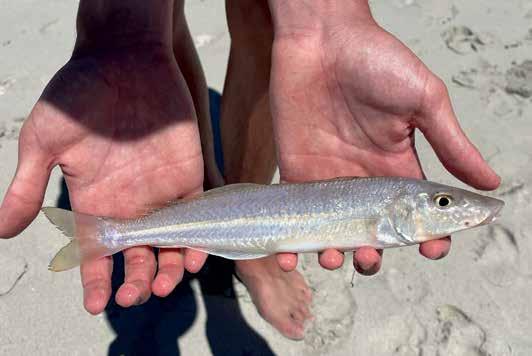
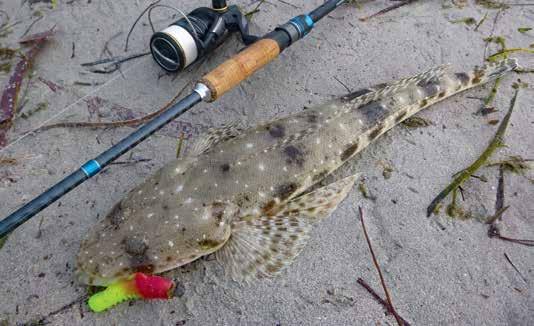
Try casting baits into the sandy clearings when targeting King George but expect quite a few rock cod in between the target species.
Some good locations on the north coast include the headlands at Stokes Bay, Snellings Beach, King George Beach and Western River Cove, while on the east coast the headlands within the Lashmar Conservation Park front nice water. There is a plethora of other headlands along the north coast but on private property, so they are not accessible unless you know the local farmer. There are some amazing rock fishing locales along the south coast and western end, but given the high energy of these coastlines extreme caution is required. If you are willing to don some hiking boots and cover some distance by foot, then you’ll be able to access some beautiful rock ledges within the south and
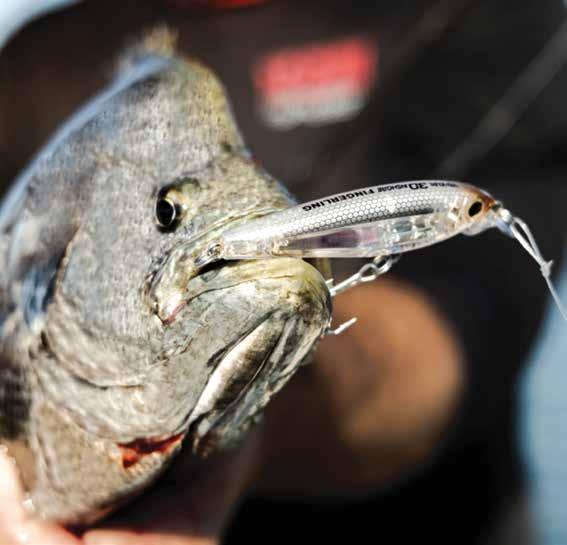








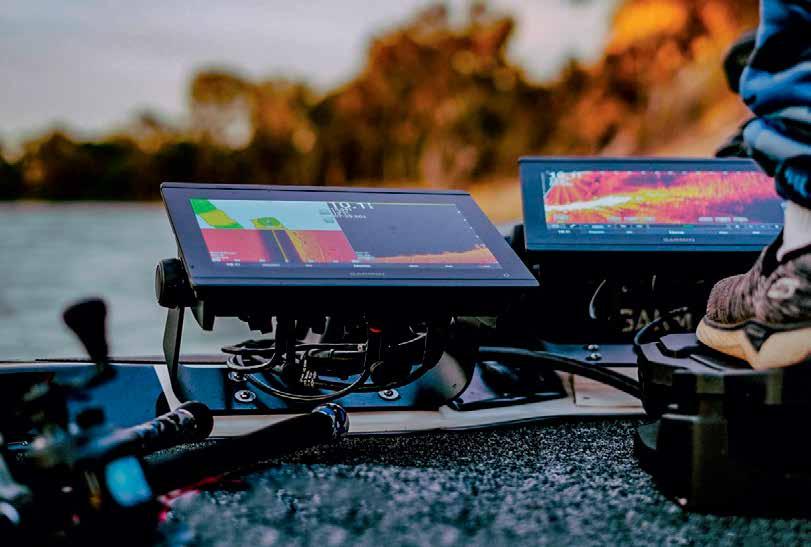

west coast national parks and conservation reserves. Species from these higher energy platforms include big salmon, silver trevally and sweep in the middle column, along with pink snapper and blue groper by soaking baits on the bottom. Deep-water species such as red snapper, swallowtail and harlequin fish are also a possibility from the deeper ledges, but expect a fair bit of by-catch off these rocks.
There are plenty of attractions and sightseeing to do on the island to keep the whole family entertained. We always enjoy heading to Flinders Chase National Park at the western end of the island to visit renowned landmarks such as Admirals Arch, Remarkable Rocks, Weirs Cove, Cape Borda Lighthouse and Cape du Couedic Lighthouse.
This national park, combined with the adjoining Ravine des Casoars Wilderness area encompasses almost 75,000 hectares of bushland up the western end of the island, and there are plenty of dedicated walking trails to tackle too.
Guided tours are offered at Seal Bay and Killy Hill Caves, both on the south coast of the island, plus sandboarding at Little Sahara. Raptor Domain Conservation Centre is a fantastic attraction, also located on the south coast of the island, that offers interactive free-flight bird and reptile presentations. For the foodie, there’s Clifford’s Honey Farm, plus several local wineries to visit.
And of course, aside from these tourist attractions, the island offers abundant natural attractions that will leave you breathless, from the sheltered coves of the north coast to the rugged surf beaches of the south. Kangaroo Island certainly is South Australia’s slice of island paradise.

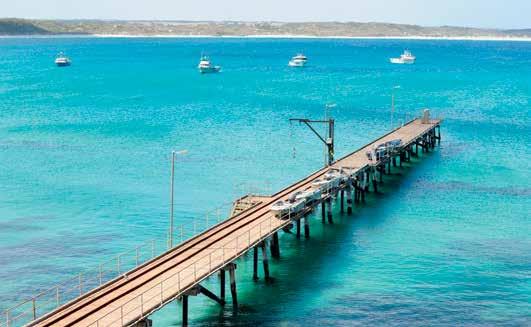

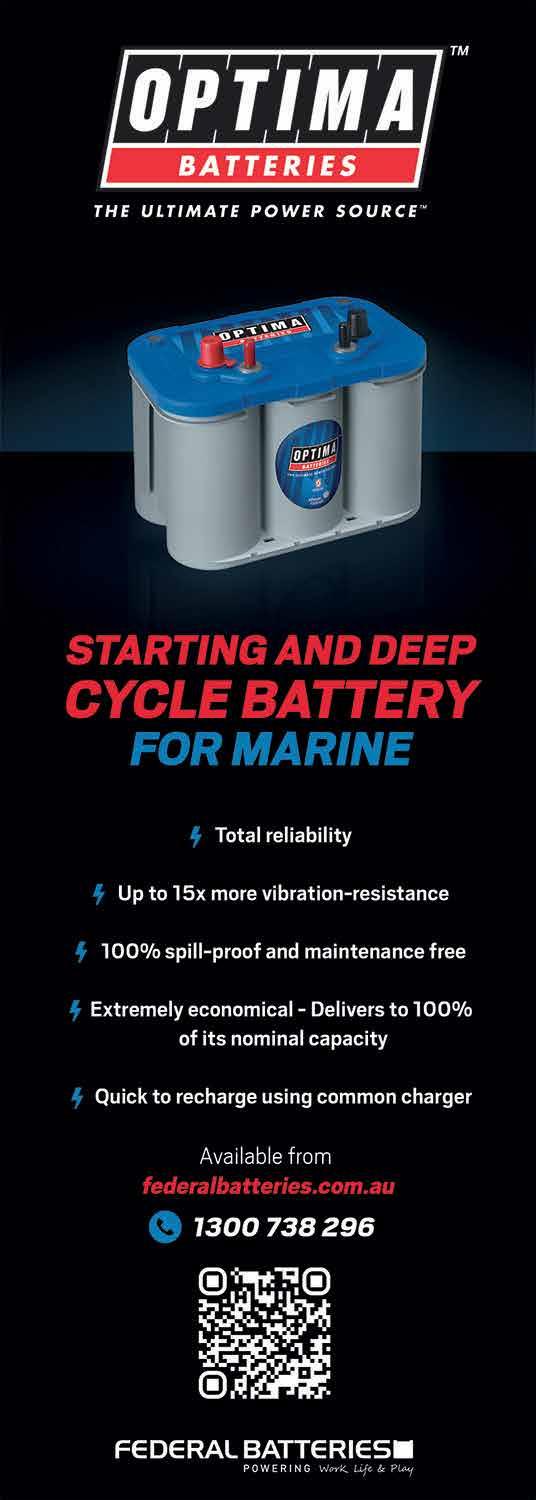


The world’s most realistic micro jigs. Choose your target then choose your type.
TYPE ZER0: 20g, 30g, 40g, 60g, 80g

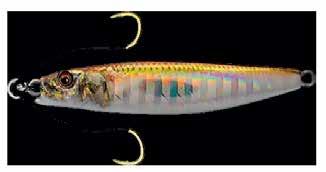
TYPE 01: 12g, 18g, 30g, 40g, 60g 80g

TYPE 02 REBORN :30g, 40g, 60g
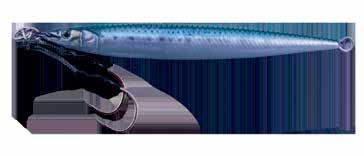
TYPE 05: 60g, 80g
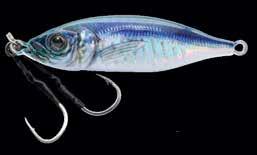
TYPE 06: 10g, 20g, 30g, 40g, 60g, 80g, 100g, 125g, 150g
www.gladiatortackle.com.au
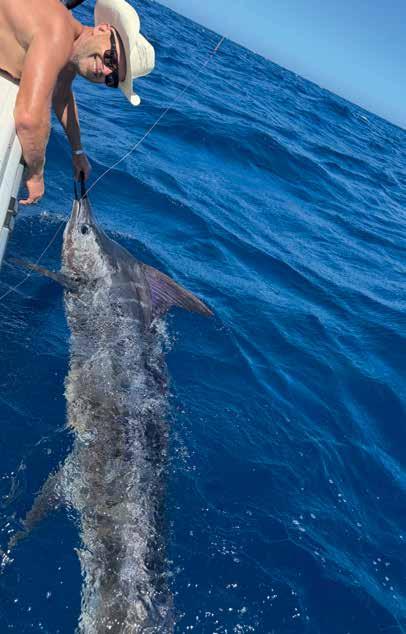
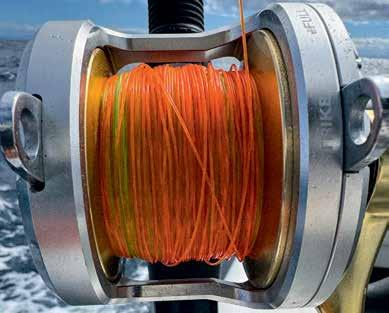

The Shimano Talica may seem like a standard reel you’d find on any serious game angler’s boat, but it wasn’t always this way. It first emerged onto the scene in 2010, among quite a few other Shimano overhead reels with names that all began with a T – Tiagra, Trinidad, Torsa, Torium, Tyrnos, and TLD – so it was fair that anglers weren’t instantly aware of what the Talica offered or where it sat in the line-up. It also wasn’t cheap, and it’s hard to pull an angler away from the classic Tiagra, which has been a staple for serious game anglers for over 20 years.
The Talica came in multiple sizes, with both single gear ratio and two-speed variants. It’s now available in sizes 10, 12 and 16 in single speed, and 8, 10, 12, 16, 20, 25 and 50 in two-speed. The 2024 release of the Talica II introduced new 8, 10 and 12 sizes in two-speed variants, along with updated and improved versions of the 20 and 25 –which is the focus of this review. But first, a bit of history and why this reel became such a weapon for the modern game angler.
Slowly, game anglers caught on to the fact that it was a superior mini-game reel to anything that had come before and had
I was an early adopter of the Talica and immediately saw its potential and the advantages of fighting fish with lighter rods TESTED & REVIEWED
brought game reels into the future. It was more compact, lighter, smoother in operation, braid-friendly, and offered huge line and drag capacity for its relative size. It was also castable (or perhaps more accurately, pitchable), which suited the emerging NSW South Coast marlin scene that was gaining traction thanks to a strong return of the species and more effective angling methods such as slow trolling livebaits and pitch baiting.
and without the need for cumbersome gimbals or harnesses when pitching and slow trolling livebaits for striped marlin on the NSW South Coast. In the 50 size it was also fast becoming the go-to reel for broadbill swordfish among anglers in Tasmania, who were among the first in the country to successfully target them during daylight hours.
It might seem hard to believe now, but I recall being on boats with mates running a fleet of Tiagras who wouldn’t let me put the Talica in the spread. Slowly, most light to medium tackle game anglers came around and realised how good this reel really is – and now it’s been improved. I’ve gone on to catch countless marlin and multiple broadbill on this reel across many boats and I genuinely don’t know of anything else that can rival it. While Tiagras will always have their place in my reel fleet, Talicas have replaced them when targeting marlin on the NSW South Coast.
I purchased two of the new Talica 20IIA models at the start of this year’s marlin season. I was keen to see how the upgrades translated on the water, and whether the changes were noticeable and advantageous.
The first major improvement was instantly obvious when spooling up. For marlin, my setup is fairly simple: 60lb braid, a 150lb shock leader tied with an FG knot, and a 4/0 circle hook crimped on. What stood out immediately with the new Talica is that the frame is now evenly balanced. On the original model, the circumference was wider on the right-hand side where the gear housing sits. This new design lays the leader more evenly on the spool, feels better on the rod, and generally handles better.
The new model is noticeably smoother when cranking under heavy load, thanks to refined
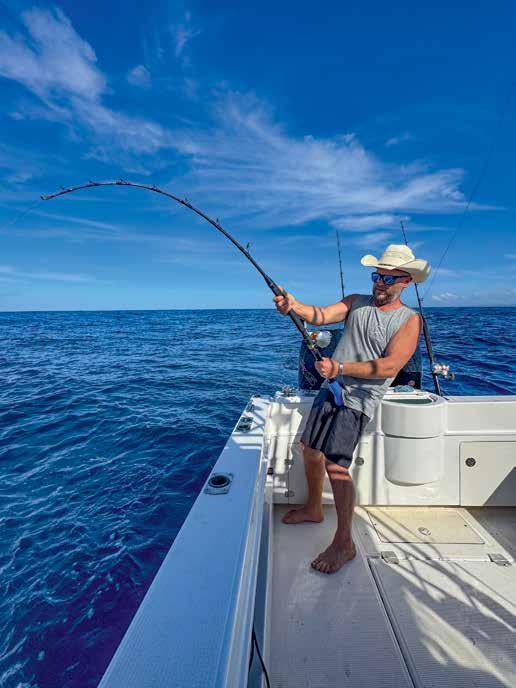
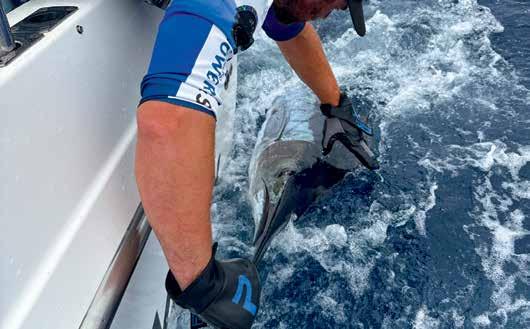
lower gear ratios. The Talica 20II maintains the same high gear ratio of 5.2:1, but the low gear ratio has been reduced from 2.3:1 to 1.9:1. This change delivers noticeably more torque, making it easier to wind in heavy, hard-fighting fish – especially during the final stages of the fight. This feeling of smoother, more controlled operation is further enhanced by Shimano’s Infinity Drive technology, which reduces side-load pressure on the main shaft and results in up to 40% lighter rotation under heavy drag. I generally run around 8kg of drag pressure, and occasionally bump it up to 12kg. We caught multiple marlin to 130kg on the new Talica, and the difference was clear. My 14-year-old son managed to knock over several marlin in a single day under these pressures without too much of a struggle.
The drag is noticeably smoother, thanks to
the upgraded Cross Carbon Drag system. While it’s capable of delivering up to 25kg of drag, we never push anywhere near that level. The drag is consistent and responsive across a range of pressures – from just in gear while feeding out a bait, through to strike and heavier drag near sunset (which I set at 13kg).
The handle has also been tweaked. The 20 still features the ball knob, but it’s been reshaped and feels more comfortable in the hand.
The Talica comes with two cams that are easy to change out – the standard cam and a ‘light game’ cam. Personally, I’ve never felt the need to use the light cam. It’s labelled ‘light game’ on the cam and in the manual and is said to offer a steeper drag curve with a recommended lighter drag capacity. Some good anglers I know have switched it out, but I couldn’t see the benefit. After chatting with Hooked Up’s esteemed editor, we decided to scale-test both cams.
We didn’t notice any real difference apart from the light cam not achieving as much drag at the top end – the difference was only about 2 kilos. We contacted Shimano to ask if using the light cam with heavier than recommended drag would negatively affect the reel. Their response was that it wouldn’t. We were left scratching our heads about what the second cam actually does. The manual claims it changes the curve, but it doesn’t –and both cams let you set the drag however you like. It may affect the inertia of how the drag starts up, which can’t really be measured on a scale. So, to play it safe: if you’re chasing IGFA or GFAA records with light mono, use the light cam. If you’re fishing heavy braid, stick with the standard cam.
The key takeaway here – whether you’re using a Talica or any lever drag reel – is to set your drag with quality scales. Do it off the rod, get it right, and don’t let anyone fiddle with the cam dial once it’s set.
The Talica was already an outstanding reel, and Shimano has managed to refine and improve it even further. The differences are real and noticeable, and I’ll be swapping out my current Talicas for the new model without hesitation.
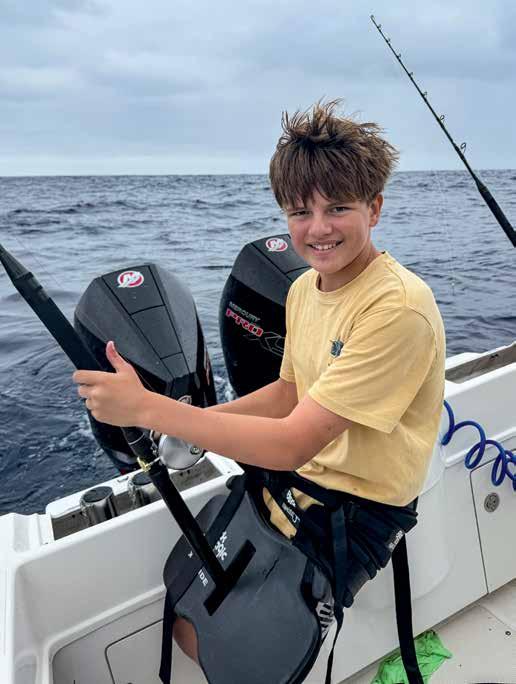

We’re helping freshwater catfish continue on their road to recovery with more than 25,000 to be relocated to new homes.
Catfish were moved from a private dam near Lancefield, and lakes near Hopetoun and Woomelang, to:
» Ovens River (580 catfish)
» Broken Creek (290)
» Campaspe River (163)
» Phyland Lagoon (181)
» Lake Sambell (290)
» Dunyak Moira (171)
» Harcourt Park Dam (165)
» Dam near Upotipotpon (290)
» Sandilong Creek, near Mildura (18).
The project is a collaboration with several CMAs, Ecology Australia, traditional owner groups and fishers. Relocations can help fast-track the recovery of wild populations, which could mean more angling opportunities in the future.
We also salvaged 23,000 catfish from Lake Lascelles and took them to our Arcadia hatchery for genetic testing. Most will be released, with 75 mature catfish retained at Arcadia, which is being tripled in size as part of the State Government’s $96 million Go Fishing and Boating Plan.
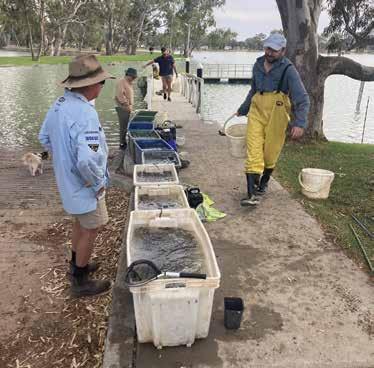

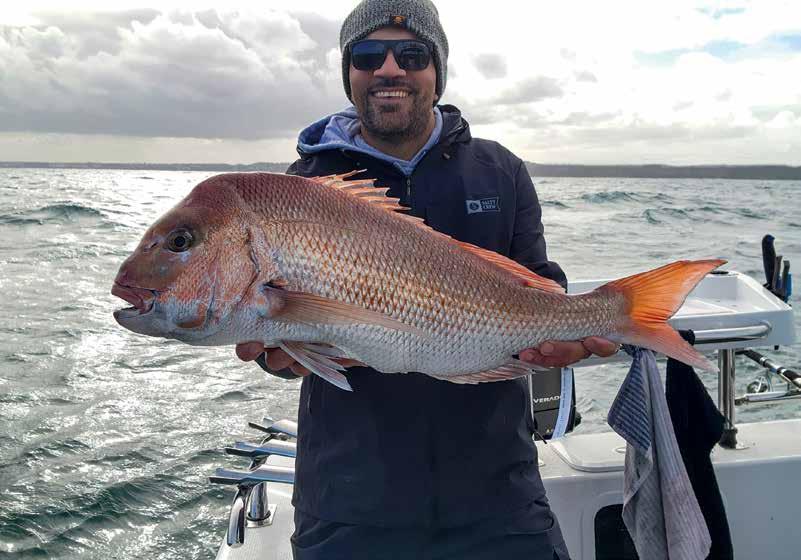
Words & Images: Kosta Linardos
As someone who’s spent their life fishing in Victoria – where you can get four seasons before lunch – good clothing isn’t just a luxury, it’s a necessity. I’ve owned countless jackets and bibs over the years. In fact, I’ve got a cupboard full of them. But after spending over 12 months in the Salty Crew Long Range Bib and Jacket, I can safely say these are some of the best I’ve worn.
In the US, bibs (essentially overalls for anglers) are standard fishing wear. Whether it’s bass boats inshore or big boats offshore, American anglers know the value of a bib. Here in Australia, particularly in the southern states, a few of us have cottoned on – but not enough.
I reckon that’s due to two things: cost (US imports have always been dear), and a general lack of awareness about how bloody useful they are.
The Salty Crew Long Range Bib is a game-changer. Made from lightweight yet extremely waterproof 10K/10K laminated nylon with fully taped seams, it keeps you dry without weighing you down. That means you can wear it through spring and autumn or layer up underneath for winter. It’s not bulky, so it won’t restrict your movement on the boat – and that makes a big difference when you’re climbing around gear, getting the boat ready, or
leaning over to grab a fish.
The beauty of a bib such as this starts before you’ve even hit the water. Anyone who’s ever stepped into a boat covered in dew first thing in the morning knows the horror of a wet crotch. I chuck my Long Range Bib on before I even leave the house. It keeps me dry as I load the boat and walk around the ramp. With it on, I can wear fewer layers, stay dry, move freely and feel more comfortable all day.
Out on the water, the benefits are even more obvious. Boats get you wet long before any spray or rain arrives – berley, bait, buckets of water, deck wash, you name it. And once you’re damp, that’s you
done for the day. But with the Salty Crew bib, that doesn’t happen.
Functionality is another big tick. The Long Range Bib includes a cargo pocket that securely holds your phone and keys. It’s something you’ll appreciate every time you launch or retrieve your boat at the ramp. There’s also a tool pocket that keeps pliers within easy reach and hand warmers on each side – absolute gold on those icy winter mornings.
When the fishing’s over, the bib continues to shine. Covered in blood, bait and saltwater? No worries. Just peel it off before you get in the car and your clothes stay clean. When you get home and it’s time to wash the boat, just slip the bib back on – it keeps you dry again during a job that usually leaves you soaked.
Compared with other bibs I’ve owned, the Long Range stands out. It’s just as waterproof, significantly lighter, and the straps and buckles don’t tangle – a small but very real frustration with other brands. Best of all, it can handle the washing machine. I’ve washed mine countless times without issue, which speaks volumes about its durability.
The Long Range Jacket pairs beautifully with the bib. It’s also lightweight, fully seam-sealed, highly waterproof and looks great. Like the bib, it’s built for layering and has no problem in the wash. Together they offer full coverage and comfort, while still being compact enough to stash on the boat when the weather warms up.
But what really sets the Long Range range apart is the price. At $239.99 for the bib, it has no peer. Comparable products can easily be double the price. And sure, maybe the materials in those other brands are a touch thicker, but for boat use, I don’t need that. I’m not bashing through bushes or rubbing up against rock walls. I want lightweight, I want dry, and I want value. Salty Crew delivers on all fronts.
After 12 months of heavy use, I haven’t had a single issue. While the bib and jacket might not be as warm as some thicker options, the money saved easily covers a quality set of merino thermals – keeping you just as warm, and a whole lot less bulky.
For southern anglers who fish from open boats or deal with unpredictable conditions, the Salty Crew Long Range Bib and Jacket offer unbeatable performance, comfort and value. It’s time more Aussies caught on.

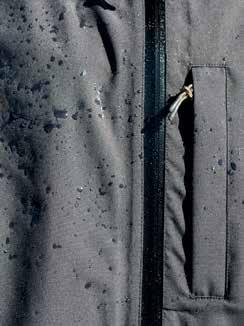
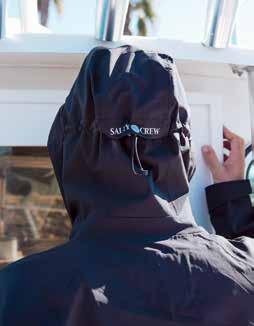
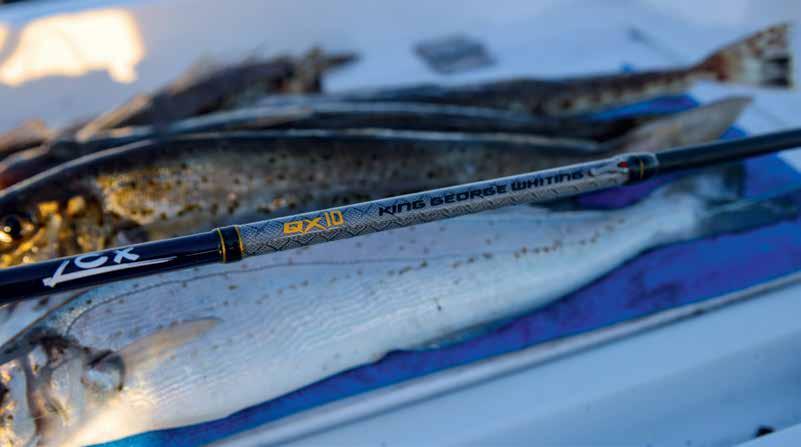
Words
& Images: Kosta Linardos
For far too long, bait fishers have been overlooked. While lure anglers enjoy a smorgasbord of technique-specific, highperformance graphite rods, bait rods have often been relegated to cheap glass blanks with little thought to action, ergonomics or purpose. But bait fishing is every bit as technical and finesse-driven as lure fishing –especially when chasing sensitive biters such as King George whiting. Finally, someone has stepped up and recognised this. Enter the new Lox QX10 King George Whiting Special, a purpose-built rod that delivers the feel, control and durability bait anglers deserve.
This rod is part of the newly released Lox QX10 series – five models in total, each engineered around a specific technique. The whiting special is, in my opinion, the standout not only because it performs exceptionally but because it fills a gap that has long existed in the market. Built on a high-modulus Japanese Toray carbon blank, combining both 30T and 46T fibres, this rod delivers sensitivity in spades while maintaining
power in the butt to handle heavy leads and incidental bycatch. It’s a delicate balance that Lox has absolutely nailed. At 7ft 6in the length is perfect and armed with Fuji K guides – all the componentry is spot on.
At the core of the blank is Lox’s IV Core Loop technology, which helps stabilise the blank during loading and unloading. This results in faster recovery, greater casting accuracy (not that you really need it in this instance), and superior bite detection – attributes that are especially useful when you’re fishing in deep water or strong currents and trying to identify those subtle, tell-tale taps from a whiting as opposed to a wrasse or toadie. It’s surprising how often your first cast will tell you whether you’re in a productive spot, and with this rod, you’ll know within seconds.
I fish the south of Port Phillip, often in deep water with significant current, and I regularly use sinkers up to 5oz. The Lox QX10 handles
that without breaking a sweat. It’s got the backbone to load and carefully lob a heavy rig accurately and safely without putting stress on the graphite. That said, you do need to remember that graphite is not fibreglass –this isn’t a rod for hard, full-force casts over the head. It’s designed for gentle lobs, which is exactly what you should be doing when anchored over sand holes anyway. In this context, the rod shines. It’s forgiving enough to absorb headshakes and those darting dives but fast enough to respond the instant you need to strike.
Where this rod truly excels, though, is in the way it’s been designed around real baitfishing needs. Too often, rods marketed as ‘light’ or ‘sensitive’ come with short butts and exposed graphite – clearly aimed at lure anglers. But a bait rod lives in the snapper racks just as much as in your hands, and it needs a long full-length EVA for durability and practicality. Lox clearly understands this. The butt is long enough for effective leverage and fits snugly in a holder without scuffing
or causing stress fractures in exposed graphite. It balances beautifully with a 2500-size reel – I ran mine with a Daiwa Sol, PE1 braid, and 12lb leader, and the pairing was near-perfect.
Hook-ups have been outstanding. Whether using long-shank hooks and striking quickly, or circle hooks that respond best to a slow lift, the rod has the action and responsiveness to deliver. When the bites came thick and fast, I had no trouble swinging whiting and hefty sinkers straight into the boat. That might sound minor, but in a hot bite, speed and efficiency make a real difference. Less fumbling means more fish in the Esky and fewer missed chances.
It also speaks to a larger issue in our local market – the lack of species-specific gear. Overseas, in Japan, Europe and the US, rods are often tailored to specific species and techniques. Australian anglers, by contrast, have long been sold the dream of ‘do-it-all’ rods, which usually means they do everything adequately but nothing exceptionally. It’s refreshing to see Lox and the team at Viva take the leap and create a purposedriven rod for one of our most targeted species. According to recent VRFish data, King George whiting are the most targeted species in Victoria, and I reckon the numbers would be similar in WA and SA. Why, then, has it taken this long for a proper whiting rod to hit the shelves?
That’s why I’m genuinely excited about this release. The Lox QX10 isn’t a repurposed estuary rod or a watered-down bream stick. It’s a whiting rod – designed from the ground up for bait anglers who know the joy and challenge of this style of fishing. It respects the species and the angler. And in doing so, it makes every session that bit more enjoyable and productive.
Aesthetically, it’s a head-turner. The deep navy blank, snake-skin pattern detail and minimal, clean graphics give it a premium look without being flashy. It’s a rod that feels as good in the hand as it looks leaning on the gunnel. And for the price, I honestly don’t think there’s anything else on the market that caters this specifically to whiting.
In short, the Lox QX10 King George Whiting is a rod I’ll be using for years to come. It’s technically advanced, thoughtfully designed, and built for a job that’s long been underserved. If you fish for King George whiting – whether casually or religiously – you’ll immediately notice the difference in feel, performance and results. Priced at $299 (but you’ll most likely find it for around $250) it’s a solid investment. The rule of thumb is spend the most on the gear you use the most, so have a think about species of fish you catch the most of, and the price of 20 King George at the market, and you’ll see a worthy investment.
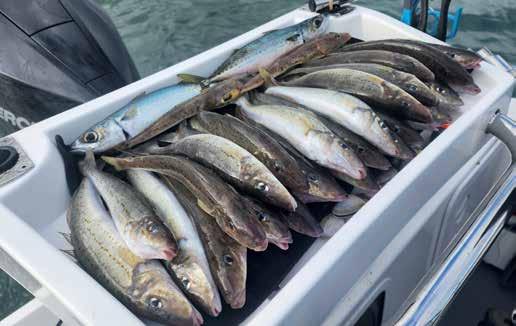
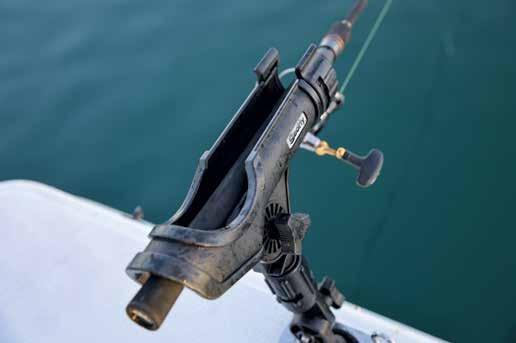
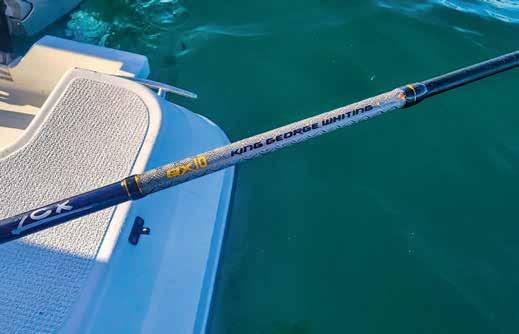
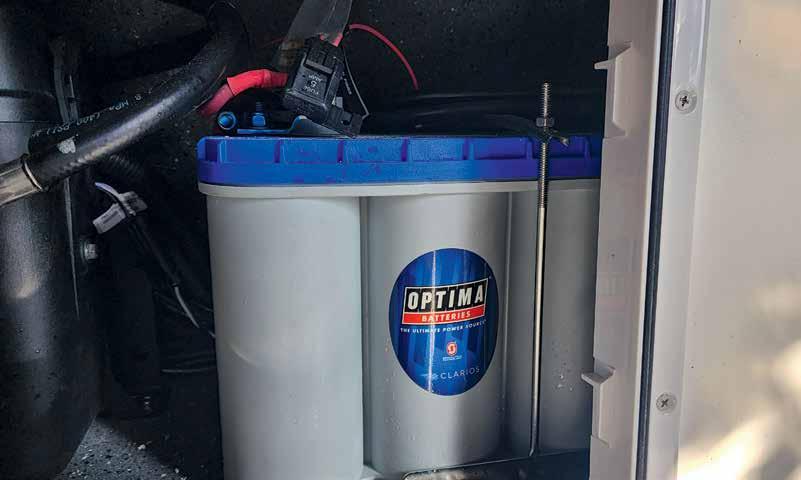

When it comes to boating, you’re only as good as your power system. If your battery fails, your day’s done—simple as that. Over the past 12 months, I’ve been running a pair of Optima Blue Top 75Ah 900CCA batteries in my 6m Edencraft, and they’ve proven to be the real deal: reliable, powerful, and truly built for marine use.
My Edencraft is a serious offshore rig, powered by a Mercury Verado 300hp and loaded with electronics for full-day missions. One Blue Top runs as the crank battery, the other powers everything else— dual Simrad MFDs (12in and 16in), live well, radar, autopilot, lighting, deck wash, phone charger, and a downrigger. That’s a massive draw, and these batteries haven’t skipped a beat.
The secret lies in their spiral-wound AGM design. Unlike flat-plate batteries, the Blue Top uses cylindrical cells that offer lower internal resistance, faster recharge times, and better vibration resistance. Offshore
conditions can shake lesser batteries to bits, but even in rough water, these units stay rock-solid.
With 900 cold cranking amps, the Verado fires instantly every time—even after hours of drifting with everything running. And as a house battery, it’s equally impressive. I’ve experienced zero voltage drops, no screen flickers, and no annoying battery alarms. Everything stays stable, even with radar spinning, lights blazing, and pumps churning.
Compact and easy to mount, they also free up hatch space and look the part with a rugged, marine-grade finish. The sealed AGM design means no maintenance, no spills, and no corrosion. They can even be mounted in different orientations—perfect for tight installs.
These aren’t budget batteries—expect to pay around $550 each—but they’re an investment, not a cost. When you’re wide offshore, you don’t get second chances
the Blue Tops give peace of mind and performance, trip after trip.
It’s worth noting that even the best batteries rely on a quality fit-out. Mine was handled by the team at Marine Tech, and it’s made a big difference. Good wiring won’t save a bad battery, but it will get the most out of a great one.
After a year of hard use in all conditions, both batteries still perform like new. In a world full of gear that’s labelled ‘marine’ but barely makes the cut, the Optima Blue Top stands apart. Whether you’re running a simple inshore set-up or a high-end offshore weapon, these batteries deliver power you can count on. I highly recommend you considering them for your next fit out or battery replacement.
